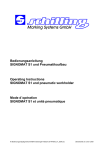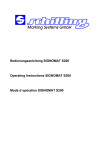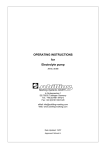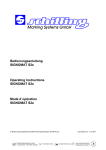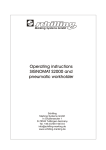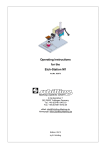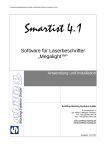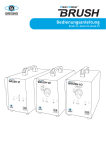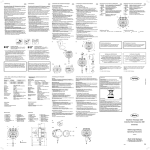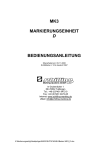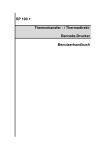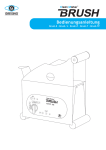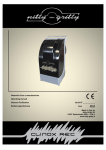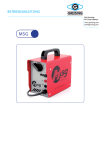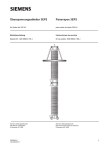Download Bedienungsanleitung SIGNOMAT S100 (52.008
Transcript
Bedienungsanleitung SIGNOMAT S100 (52.008) und Pneumatikaufbau (56.075) Operating Instructions SIGNOMAT S100 (52.008) and pneumatic workholder (56.075) Mode d´opération SIGNOMAT S100 (52.008) et unité pneumatique (56.075) K:\Bedienungsanltg\Signiertechnik\BA-Erstellung\S100-Bedanl_DE-GB-FR.doc Schilling Marking Systems GmbH In Grubenäcker 1 DE-78532 Tuttlingen +49 (0)7461 9472-0 +49 (0)7461 9472-20 Überarbeitet am: 11.04.2014 www.schilling-marking.de [email protected] Bedienungsanleitung SIGNOMAT S100 Operating instructions SIGNOMAT S100 Mode d´opération SIGNOMAT S100 Updated: 04/2014 2 VORWORT Sehr geehrter Kunde, Sie haben mit der Anschaffung der SCHILLING Beschriftungsanlage SIGNOMAT S100 eine gute Wahl getroffen, und wir danken Ihnen für das Vertrauen, das Sie unserem Produkt entgegenbringen. Ihre Anlage würdigt dieses Vertrauen, doch stellt sie von Anfang an eine Bedingung: Sie wünscht immer, auch unter den rauesten Bedingungen, anständig behandelt zu werden. Deshalb gehört diese Bedienungsanleitung in die Hände des Bedienungspersonals. Es wäre verfehlt, diese im Betriebsarchiv ein verstaubtes Dasein fristen zu lassen. Wir haben deshalb versucht Ihnen alle Hinweise und Informationen zu geben, die für die Bedienung, Wartung und Überwachung der Anlage notwendig sind. Bitte lesen Sie diese Anleitung VOR DER INBETRIEBNAHME der Anlage aufmerksam durch und machen Sie sich mit ihr vertraut. Wenn Sie genau allen Anweisungen folgen, werden Sie Zeit sparen und Verlusten vorbeugen, und Sie werden mit der Leistung der Anlage nach Jahren noch voll zufrieden sein. Wir wünschen Ihnen erfolgreiche Arbeit und beste Ergebnisse mit Ihrer SCHILLING-Anlage. Vielen Dank für Ihre Aufmerksamkeit und einen guten Start! INTRODUCTION Dear Customer, You have made a good choice by purchasing a SIGNOMAT S100 Marking System. Thank you for your trust in our product. Your system will honour this trust, but there will be one condition to satisfy right from the onset: The system should always be treated with respect, even under the most ardent of conditions. Therefore, these Operating Instructions should be kept with operators. It would be a mistake to have these Operating Instructions rot away under heaps of dust. We have therefore endeavoured to give you all the recommendations and information necessary for operating, servicing and monitoring your system. Please read these Instructions carefully PRIOR TO COMMISSIONING the system in order to become familiar with them. Following these Instructions precisely will save you time and prevent losses, and you will still be fully satisfied with the system’s performance in years to come. We wish you success in your work and optimal results by employing your SCHILLING System. Thank you for your attention and have a good start! INTRODUCTION Cher client, Vous avez fait un bon choix avec l’achat d’un système de marquage SIGNOMAT S100 de SCHILLING. Nous vous remercions pour votre confiance en nos produits. Votre machine honore votre confiance, mais demande une condition pour toujours fonctionner parfaitement. Elle souhaite, d’être manipulée avec précaution, même dans des conditions difficiles. Par conséquent, ce mode d’opération appartient aux mains de l’employeur. Ce serait une erreur, de laisser ce mode d’opération atterrir aux archives! C’est pourquoi, nous avons essayé de vous donner toutes les recommandations et informations qui sont nécessaires à l’emploi, au service, et contrôle de votre machine. Lisez, s’il vous plaît, attentivement ces instructions AVANT LA MISE EN MARCHE de la machine, et mettez vous en confiance. Si vous suivez exactement ces instructions, vous économiserez du temps et éviterez des faires des erreurs. Vous serez satisfait de la performance de votre machine pendant des années. Nous vous souhaitons du succès et de bons résultats avec votre machine SCHIILLING. Nous vous remercions pour votre attention et bon départ! Schilling Marking Systems GmbH In Grubenäcker 1 DE-78532 Tuttlingen +49 (0)7461 9472-0 +49 (0)7461 9472-20 www.schilling-marking.de [email protected] Bedienungsanleitung SIGNOMAT S100 Operating instructions SIGNOMAT S100 Mode d´opération SIGNOMAT S100 Inhalt: Contents: Sommaire: 1. 2. 3. 4. 1. 2. 3. 4. 1. 2. 3. 4. Sicherheitshinweise 3 Bestimmungsgemäßer Gebrauch 4 Technische Daten 4 Herstellerinformation 4 -Hersteller 4 -Änderungen 4 -Vertraulichkeit 4 5. Maschine, Bedienelemente Signomat S100 5/6 6. Transport, Montage und Inbetriebnahme 6 7. Maschine, Bedienelemente Pneumatikaufbau 7/8 8. Arbeiten mit dem Signomat S100 8/9 9. Arbeiten mit dem Zubehör 10 10.Arbeiten mit dem Pneumatikaufbau 10 -Anschluss der Kabel 10 -Anschluss des Elektrolytschlauches 10 -Positionierung von Werkstück und Schablone 11 -Elektrolytfluss 11 -Anpressdruck regeln 11 -Probelauf 12 -Ende der Signierung 12 11.Verbesserung der Signierung 12 12.Kurzschluss und Überlast 12 13.Wartung und Pflege 13 Bestellwesen 14 -Stempel + Schablonen 14 -Elektrolytverwendungsliste/ Chemikalien 15/16 Diese Bedienungsanleitung ist eine wichtige Grundlage für fachgerechte Bedienung und Wartung der Geräte. Sorgen Sie deshalb dafür, dass die Bedienungsanleitung für den Bediener jederzeit verfügbar ist. 1) Sicherheitshinweise Berühren Sie bei eingeschaltetem Gerät nie direkt mit dem Handstempel die Kontaktplatte des Signomat S100, sonst gibt es einen Kurzschluss. Sollte dies doch einmal geschehen sein, sehen Sie im Abschnitt „Kurzschluss“ nach, was zu tun ist. Der SIGNOMAT S100 ist bei bestimmungsgemäßem Gebrauch ungefährlich. Trotzdem sollten Sie im Gebrauch der Chemikalien einige Dinge beachten: Benutzen Sie Gummihandschuhe. Die Augen mit Schutzbrille vor Elektrolyt, Neutralyt und Konservat schützen. Sollten die Augen trotzdem einmal Kontakt mit den Chemikalien haben, spülen Sie die Augen sofort gründlich mit viel klarem Wasser, suchen Sie einen Arzt auf. Bei Haut- und Kleiderkontakt mit den Chemikalien sind diese sofort mit Wasser zu reinigen. Essen und Trinken am Signierarbeitsplatz ist verboten. Vor der Nahrungsaufnahme sind die Hände zu waschen. Halten Sie Kinder vom Gerät fern. SIGNOMAT S100 nur in trockenen Räumen betreiben. Das Gerät kann mit einer Netzspannung von 230 Volt oder 115 Volt betrieben werden. Die Umschaltung erfolgt automatisch beim Einschalten. Halten Sie explosive Gase vom Gerät fern. Vor dem Öffnen des Gerätes Netzstecker ziehen. Quetsch- und Scherstellen sind weitestgehend beseitigt. Achten Sie aber darauf, die Hände beim Arbeitsbzw. Rückhub vom Pneumatikaufbau fernzuhalten. Schilling Marking Systems GmbH In Grubenäcker 1 DE-78532 Tuttlingen Safety instructions 3 Scope of application 4 Technical data 4 Manufacturer information 4 -Manufacturer 4 -Alterations 4 -Confidentiality 4 5. Machine, control elements Signomat S100 5/6 6. Transport, installation and start-up 6 7. Machine, pneumatic work holder and control elements 7/8 8. Working with the Signomat S100 8/9 9. Working with the accessories 10 10.Working with the pneumatic work holder10 -Connecting the cables 10 -Connecting the electrolyte hose 10 -Positioning the workpiece and stencil 11 -Electrolyte flow 11 -Regulating the contact pressure 11 -Test run 12 -End of marking procedure 12 11.Improving the marking results 12 12.Short circuit and overcharge 12 13.Servicing and maintenance 13 Ordering 14 -Stamps + stencils 14 -Use of Electrolytes/Chemicals 17/18 These operating instructions form is an important prerequisite for the proper operation and maintenance of the equipment. Therefore, please ensure that the operating instructions are kept available for the operating personnel at all times. 1) Safety instructions Never allow the manual stamp to touch the contact plate of the Signomat S100 directly when the machine is switched on, as this results in a short circuit. Should this happen, please refer to the section „Short circuit“ for instructions. When used properly, the SIGNOMAT S100 is operationally safe. Still, a few points should be noted for the handling of chemicals: Use rubber gloves. Eyes must be protected against electrolyte, neutralyte and preserving agent. Should eyes come into contact with the chemicals, immediately rinse eyes thoroughly with clear water and contact a physician. Do not swallow electrolyte, neutralyte and preserving agent. Should electrolyte be swallowed, immediately drink a large glass of clear water and contact a physician. Should skin or clothing come into contact with the chemicals, rinse immediately with water. Eating or drinking at the workplace is prohibited. Hands must be washed before eating. Keep children clear of the machine. Use the SIGNOMAT S100 in dry locations only. This machine can be operated with 230 Volt or 115 Volt. The adaptation is carried out automatically when switching on the device. Keep explosive gases clear of the machine. Disconnect the mains plug before opening the machine. Most points at which danger of injury exist have been eliminated. However, please take care to keep hands away from the pneumatic work holder during the working and return strokes. +49 (0)7461 9472-0 Updated: 04/2014 3 Consignes de sécurité 3 Utilisation réglementaire 4 Caractéristique techniques 4 Informations concernant le fabricant 4 -Fabricant 4 -Modifications 4 -Confidentiel 4 5. Machine, éléments de commande Signomat S100 5/6 6. Transport, montage et mise en service 6 7. Machine, éléments de commande unité pneumatique 7/8 8. Opération avec le Signomat S100 8/9 9. Opération avec les accessoires 10 10. Opération avec l´unité pneumatique 10 -Raccordement des câbles 10 -Raccordement du tuyau flexible à électrolyte 10 -Positionnement pièce à marquer et pochoir 11 -Flux de l´électrolyte 11 -Réglage de la pression d`application 11 -Essai 12 -Fin de marquage 12 11. Amélioration du marquage 12 12. Court-circuit et surcharge 12 13. Entretien et maintenance 13 Commandes 14 -Tampon + pochoir 14 -Utilisation des Électrolytes/ Produits électrochimiques 19/20 Ce mode d´utilisation contient les informations essentielles pour assurer l´utilisation et l´entretien des appareils, conformément aux exigences techniques. Veillez à ce que ce mode d´opération soit toujours à disposition de l´utilisateur. 1) Consignes de sécurité Lorsque l´appareil est en marche, ne jamais mettre en contact le tampon manuel avec la plaque porte-contact du Signomat S100, sinon il y a un court-circuit. En cas de courtcircuit, consultez le paragraphe „courtcircuit“ afin de savoir procéder. Le SIGNOMAT S100 est sans dangers dans la mesure où il est utilisé correctement. Cependant, vous devez prendre certaines remarques en considération lors de l´utilisation des produits électrochimiques: Utilisez des gants en caoutchouc. Portez des lunettes protectrices afin de protéger vos yeux contre les effets de l´électrolyte, du neutralyte et du produit de conservation. Dans le cas où des produits électrochimiques vous pénètrent dans les yeux, rincez les grandes eaux claires et consultez un médecin. Ne pas avaler de l`électrolyte, du neutralyte ou du produit de conservation. Si vous avez avalé de l´électrolyte, buvez un grand verre d´eau claire et consultez un médecin. Si les produits électrochimiques entrent en contact avec la peau ou les vêtements, nettoyez aussitôt avec de l´eau. Il est interdit de manger et de boire au poste de travail de marquage. Se laver les mains avant de consommer de la nourriture. L´électrolyte peut être éliminée dans les eaux d´évacuation. Tenir les enfants à distance de l´appareil. Mettre l´appareil SIGNOMAT S100 en exploitation uniquement dans les locaux secs. La machine fonctionne avec 230 Volt ou 115 Volt. Le basculement s’effectue automatiquement pendant la mise en marche de la machine. Tenez les gaz explosifs à distance de l´appareil. Avant d´ouvrir l´appareil, retirer la prise secteur. Dans une large mesure, les risques de coupure et d´écrasement ont été éliminés. Veillez à maintenir les mains éloignées du mouvement de course de retour ou de travail de l´unité pneumatique. +49 (0)7461 9472-20 www.schilling-marking.de [email protected] Bedienungsanleitung SIGNOMAT S100 Operating instructions SIGNOMAT S100 Mode d´opération SIGNOMAT S100 Updated: 04/2014 4 2) Bestimmungsgemäßer Gebrauch 2) Scope of applications 2) Utilisation réglementaire Die Geräte dienen ausschließlich der Signierung metallischer Gegenstände. Die Funktion und ein reproduzierbares Ergebnis ist nur mit Schilling Zubehör gewährleistet. The equipment is designed exclusively for marking metallic objects. Proper function and a reproducible result are guaranteed only when Schilling accessories are used. Les appareils servent exclusivement à marquer les objets métalliques. L´appareil fonctionne et garantit un bon résultat de reproduction uniquement lorsqu´on utilise les accessoires de la société Schilling. 3) Technische Daten 3) Technical data Typ: SIGNOMAT S100 Fabrikations-Nummer: siehe Typenschild Baujahr: siehe Typenschild Abmessungen: BxHxT 260 x 95 x 250 mm Betriebsspannung: 230 V/115 V 50/60 Hz Signierspannung: 12 V / 18 V / 24 V Signierart: hell/dunkel Nennleistung: 94 VA Gewicht: 4,5 kg Sicherung: 6 A autom. Stromüberwachung 1,00 A Schmelzsicherung 5x20mm Geräuschpegel: 20 dB Type: SIGNOMAT S100 Factory number: see nameplate Year of construction: see nameplate Dimensions: WxHxL 260 x 95 x 250 mm Operating voltage: 230 V/115 V 50/60 Hz Marking voltage: 12 V / 18 V / 24 V Type of mark: light/dark Rate power: 94 VA Weight: 4.5 kg Fusing: 6 A autom. power control 1.00 A fuse 5x20 mm Noise level: 20 dB Typ: Pneumatikaufbau* Fabrikations- Nummer: siehe Typenschild Baujahr: siehe Typenschild Abmessungen ohne Elektrolytflasche: BxLxH 260 x 380 x 532 mm Gewicht: ca. 13,5 kg Vertikaler Hub des Stempels: 50 mm Luftverbrauch bei 20 Signierungen und 6 bar: 4,4 l/min Zulässiger Druck: min 1,8 bar max 6 bar Type: Pneumatic work holder* Factory number: see nameplate Year of construction: see nameplate Dimensions without electrolyte bottle: WxLxH 260 x 380 x 532 mm Weight: approx. 13.5 kg Vertical stroke of stamp: 50 mm Air consumption per 20 markings and 6 bar: 4.4 l/min Permissible pressure: min 1,8 bar max 6bar 4) Herstellerinformation 4) Manufacturer information Schilling Marking Systems GmbH In Grubenäcker 1 D-78532 Tuttlingen Deutschland Telefon: +49 (0)7461 9472-0 Fax: +49 (0)7461 9472-20 eMail: [email protected] Homepage: www.schilling-marking.de Schilling Marking Systems GmbH In Grubenaecker 1 D-78532 Tuttlingen Germany Telephone: +49 (0)7461 9472-0 Facsimile: +49 (0)7461 9472-20 eMail: [email protected] Web: www.schilling-marking.com Änderungen: Alterations: Technische Änderungen vorbehalten. Ihre Maschine kann sich deshalb in einigen Details von den Abbildungen in diesem Handbuch unterscheiden. Dies nimmt jedoch keinen Einfluss auf die Bedienung der Maschine. Die mit “ * “ gekennzeichneten Positionen sind optional und nur bei entsprechender Bestellung im Lieferumfang enthalten. Technical alterations reserved. Your machine may therefore deviate in details from the illustrations in the manual. This does not affect the operation of the machine. The “ * ” marked positions are optional and have to be ordered separately. Vertraulichkeit: These operating instructions are to be treated confidentially. They have been provided only for use in your operation by authorized persons. The transfer of this document to third parties is prohibited and may result in damages claims. All rights, including the right to translation, are reserved. No portion of these operating instructions may be reproduced in any form or processed by means of electronic systems without written permission by Schilling. 3) Caractéristiques techniques Type: SIGNOMAT S100 Numéro de fabrication: voir plaquette Année de fabrication: voir plaquette Dimensions: LxHxL 260 x 95 x 250 mm Tens. d´exploitation: 230 V/115 V 50/60 Hz Tension de marquage: 12 V / 18 V / 24 V Type de marquage: foncé/clair Puissance nominale: 94 VA Poids: 4,5 kg Fusible: 2 A contrôle autom. du courant fusible 1,00 A 5x20 mm Niveau de bruit: 20 dB Type: Unité pneumatique* Numéro de fabrication: voir plaquette Année de fabrication: voir plaquette Dimensions sans bouteille d´electrolyte: LxLxH 260 x 380 x 532 mm Poids: env. 13,5 kg Course verticale du tampon: 50 mm Consommation d´air par 20 marquages et 6 bar: 4,4 l/min Pression autorisée: min. 1,8 bar max. 6 bar 4) Informations concernant le fabricant Schilling Marking Systems GmbH In Grubenaecker 1 D-78532 Tuttlingen Allemagne Téléphone: +49 (0)7461 9472-0 Télécopie: +49 (0)7461 9472-20 eMail: [email protected] Page d’accueil: www.schilling-marking.com Modifications: Diese Bedienungsanleitung ist vertraulich zu behandeln. Sie ist ausschließlich zur Verwendung in Ihrem Betrieb durch befugte Personen bestimmt. Die Überlassung an Dritte ist verboten und verpflichtet zum Schadenersatz. Alle Rechte, auch die der Übersetzung, sind vorbehalten. Kein Teil dieser Bedienungsanleitung darf in irgendeiner Form ohne schriftliche Genehmigung des Hauses Schilling reproduziert oder unter Verwendung elektronischer Systeme verarbeitet werden. Schilling Marking Systems GmbH In Grubenäcker 1 DE-78532 Tuttlingen Confidentiality: +49 (0)7461 9472-0 Sous réserve de modifications techniques. Il se peut que, pour quelques détails, votre machine soit différente du modèle représenté dans les illustrations de ce manuel. Cela n´a cependant aucun effet sur l´utilisation de la machine. Les positions marquées avec “ * “ ne sont que des options et ne sont comprises dans la livraison uniquement si spécifier dans la commande. Confidentiel: Ce mode d´opération doit être traité confidentiellement. Il est exclusivement destiné à une utilisation interne, dans votre entreprise, par du personnel en ayant l´autorisation. Il est interdit de le remettre à un tiers sous peine de dommages intérêts. Tous droits réservés, y compris ceux de traduction. Il est interdit de traiter par systèmes électroniques ou de reproduire une partie de ce mode d´opération, sous quelque forme que se soit, sans l´autorisation écrite de la société Schilling. +49 (0)7461 9472-20 www.schilling-marking.de [email protected] Bedienungsanleitung SIGNOMAT S100 Operating instructions SIGNOMAT S100 Mode d´opération SIGNOMAT S100 Updated: 04/2014 5 9.2 5.2 1 2 7 9.0 9.1 12V 18V 24V 6.2 4.2 3 8 6 5 4 11 10 13 8 7 12 37/55 20 18 14 17 Schilling Marking Systems GmbH In Grubenäcker 1 DE-78532 Tuttlingen +49 (0)7461 9472-0 +49 (0)7461 9472-20 www.schilling-marking.de [email protected] Bedienungsanleitung SIGNOMAT S100 Operating instructions SIGNOMAT S100 Mode d´opération SIGNOMAT S100 5) Maschine, S100 Bedienelemente SIGNOMAT Die Hauptteile und Bedienungselemente finden Sie auf Seite 5 abgebildet. 1 2 3 4 4.2 5 5.2 6 6.2 7 8 9.0 9.1 9.2 10 11 12 13 14 15 16 17 18 19 20 Gelbe Leuchte „Betriebsbereitschaft“ Grüne Leuchte „Signierstrom an“ Rote Leuchte „Überstromanzeige“ Umschalter für den Betriebsmodus Anzeige des Betriebsmodus Auswahl hell / dunkel (Tabelle beachten) Anzeige der Stromart Spannungsauswahl 12 V / 18 V / 24 V Anzeige der Signierspannung Rote Anschlussbuchse für das Werkstück Schwarze Anschlussbuchse für den Signierstempel Signierzeit vergrößern Signierzeit verkleinern Anzeige der Signierzeit (0,1 bis 9,9 Sekunden und unendlich) Ein/Aus - Schalter Anschlussbuchse für den Fußschalter Kontaktbuchse und Y1 Kabel für Anschluss des Pneumatikaufbaus* (nur 52.008) Typenschild Handstempel Kontaktklemme Rotes Kabel Schwarzes Kabel Fußschalter mit Kabel und Stecker Netzkabel Filz und O-Ring 6)Transport, Montage und Inbetriebnahme Bewahren Sie die Verpackung auf und verwenden Sie diese zum Transport wieder. Achten Sie darauf, dass alles Zubehör mitverpackt wird und die Flüssigkeitsflaschen sorgfältig verschlossen sind. Ausgelaufene Flüssigkeiten sollten unter Verwendung von Gummihandschuhen, Putztuch und Wasser aufgewischt werden. Beachten Sie dabei die Sicherheitshinweise unter Kapitel 1. Schließen Sie den Signomat mit dem Netzkabel 19 an die Netzspannung an. Schalten Sie das Gerät auf der Rückseite mit dem Schalter 10 ein. Das Gerät stellt sich automatisch auf die anliegende Netzspannung um, erkennt alle angeschlossene Komponenten und stellt den entsprechenden Betriebsmodus ein. Die Lampe 1 muss leuchten. Stecken Sie das schwarze Kabel 17 in den Stempel 14 oder 50 und in die schwarze Buchse 8 des Gerätes. Wählen Sie mit dem Taster 5, ob Sie hell oder dunkel signieren möchten. Jedes Drücken der Taste schaltet die Stromart um. Sie wird im Display 5.2 angezeigt. Wählen Sie mit dem Taster 6 die Signierspannung aus. Jedes Drücken der Taste schaltet die Signierspannung um. Sie wird im Display 6.2, als numerischer Wert (12 V, 18 V oder 24 V), angezeigt. Wählen Sie mit dem Taster 4 den Signiermodus aus. Jedes Drücken der Taste schaltet in einen anderen Modus um. Er wird im Display 4.2, grafisch (Handstempel, Handstempel mit Fußschalter oder Pneumatikaufbau mit Fußschalter), angezeigt. Prüfen Sie, ob der Stempel 14 oder 50 mit Filz und O-Ring 20 ausgestattet ist. Wählen Sie in Anlehnung an die beiliegende Tabelle „Elektrolytverwendungsliste“ den für Ihr Werkstück-Metall richtigen Elektrolyten. Die Signierdauer wird mit der Taste 9.0 vergrößert und mit der Taste 9.1 verkleinert. Die eingestellte Signierzeit kann auf dem Display 9.2 abgelesen werden. Der Bereich liegt zwischen 0,1 – 9,9s (empfohlene Signierzeit 1x4s, oberflächenbehandelte z.B. brünierte Teile 2x4s). Befeuchten Sie den Filz mit etwas Elektrolyt. 5) Machine, control elements Signomat S100 The main parts and control elements are illustrated on page 5. 1 2 3 4 4.2 5 5.2 6 6.2 7 8 9.0 9.1 9.2 10 11 12 13 14 15 16 17 18 19 20 Yellow lamp „ready for operating“ Green lamp „marking current on“ Red lamp „marking current too high“ Working mode selection Display of working mode Current selection light / dark (see table) Display of current selection Voltage selection 12 V / 18 V / 24 V Display of the marking voltage Red connector socket for workpiece Black connector socket for stamp Increment marking time Decrement marking time Display of marking time (0.1 to 9.9 seconds and unlimited) On/off switch Connection socket for foot switch Contact socket and Y1 cable for connecting the pneumatic work holder* (52.008 only) Nameplate Manual stamp Contact clamp Red cable Black cable Foot switch with cable and plug Mains cable Felt piece and O-ring 6) Transportation, installation and start up Save packaging and use for later transportation. Ensure that all accessories are packed with the machine, and that bottles containing fluids are sealed carefully. Rubber gloves, a cloth and water should be used to clean up spilled fluids. Please refer to the safety instructions given in Section 1. Connect the Signomat to mains voltage by means of the mains cable 19. Switch the machine on at the rear by means of switch 10. The machine switches automatically to the local mains voltage, recognizes the connected components and adjusts to the corresponding operating mode. Lamp 1 should light up. Plug the black cable 17 into the stamp 14 or 50 and into black socket 8 of the machine. Use switch 5 to choose either light or dark marking. Each push of the key changes the type of current. It is shown on the display 5.2. Use switch 6 to set the marking voltage. Each push of the key changes the marking voltage which is shown on the display 6.2 as a numeric value (12 V, 18 V or 24 V). Use switch 4 to select the marking modus. Each push of the key changes over to a different modus. It is shown as a graphic on the display 4.2: (Hand stamp, hand stamp with foot switch or pneumatic attachment with foot switch). Check whether stamp 14 or 50 is equipped with a felt piece and an O-ring 20. Select the correct electrolyte for the metal of the workpiece according to the attached table “Use of Electrolytes”. Use switch 9.0 to extend the marking time and switch 9.1 to reduce it. The selected marking time is shown on the display 9.2. It may range from 0.1 to 9.9s (recommended marking time is 1x4s, or 2x4s for surface treated parts e.g. black oxide). Moisten the felt piece with electrolyte. For the start-up of the pneumatic work holder, available as an optional equipment, see Section 10, „Working with the pneumatic work holder“ (page 10). 6 5) Machine, éléments de commande Signomat S100 Les composants principaux et les éléments de commande sont représentés à la page 5. 1 2 3 4 4.2 5 5.2 6 6.2 7 8 9.0 9.1 9.2 10 11 12 13 14 15 16 17 18 19 20 Voyant jaune, état de marche Voyant vert, courant pour le marquage enclenché Voyant rouge «surintensité de courant» Sélection du mode d’opération Indication du mode d’opération Commutateur clair/foncé (consulter le tableau) Indication du mode courant Choix voltage 12 V / 18 V / 24 V Indication du voltage de marquage Douille de raccordement rouge pour la pièce à marquer Douille de raccordement noire pour le tampon Augmenter le temps de marquage Diminuer le temps de marquage Indication pour la durée de marquage (0,1 à 9,9 secondes et illimité) Interrupteur marche/arrêt Douille de raccordement pour l´interrupteur à pédale Douille de contact et câble Y1 pour le raccordement au dispositif pneumatique* (seulement 52.008) Plaque signalétique Tampon manuel Pince de contact Câble rouge Câble noir Interrupteur à pédale avec câble et prise Cordon électrique Feutre et anneau torique d´étanchéité 6) Transport, montage et mise en service: Conservez l´emballage et réutilisez le pour le transport. Prenez garde à ce que tous les accessoires soient emballés avec l´appareil et que la bouteille de produits fluides soit fermée avec précaution. Essuyer les produits fluides qui se sont échappés en utilisant des gants en plastique, un chiffon et de l´eau. Respectez les consignes de sécurité présentées au chapitre 1. Raccordez le Signomat à la tension secteur en utilisant le câble secteur 19. Enclenchez l´appareil au moyen de l´interrupteur 10 se trouvant au dos de l´appareil. La machine s’adapte automatiquement à la tension de réseau locale, reconnaît tous les composants connectés et ajuste le mode d’opération correspondant. La lampe 1 doit s´allumer. Branchez le câble noir 17 au tampon 14 ou 50 dans la douille noire 8 de l´appareil. Sélectionnez au moyen de l´interrupteur 5 le type de marquage que vous voulez effectuer, clair ou foncé. Chaque pression sur la touche change le type de marquage qui est indiqué sur l’écran 5.2. Sélectionnez au moyen de l’interrupteur 6 la tension de marquage. Chaque pression sur la touche change la tension de marquage qui est indiquée sur l’écran 6.2 comme un numéro (12V / 18 V ou 24 V). Sélectionnez au moyen de l’interrupteur 4 le mode de marquage. Chaque pression sur la touche change le mode de marquage qui est indiqué sur l’écran 4.2 comme un symbole (tampon manuel, tampon manuel avec interrupteur à pédale ou dispositif pneumatique avec interrupteur à pédale). Contrôlez si le tampon 14 ou 50 est équipé de feutre et de l´anneau torique d´étanchéité 20. A l´aide du tableau „utilisation des électrolytes“ ci-joint, sélectionnez l´électrolyte adaptée au métal de votre pièce à marquer. Augmentez la durée de marquage avec la touche 9.0 et diminuez la durée de marquage avec la touche 9.1. La durée sélectionnée est indiquée sur l’écran 9.2. Le gamme est entre 0,1 et 9,9s (durée de marquage recommandée 1x4s, surface traitée p. ex. pièce brunir noire 2x4s). Humidifiez le feutre avec un peu d´électrolyte. La mise en service de l´unité pneumatique, disponible comme équipement optionnelle, est présentée au chapitre 10 „Opérations avec l´unité pneumatique“ (page 10). Die Inbetriebnahme des optional erhältlichen Pneumatikaufbaues entnehmen Sie dem Kapitel 10 „Arbeiten mit dem Pneumatikaufbau“ (Seite 10). Schilling Marking Systems GmbH In Grubenäcker 1 DE-78532 Tuttlingen Updated: 04/2014 +49 (0)7461 9472-0 +49 (0)7461 9472-20 www.schilling-marking.de [email protected] Bedienungsanleitung SIGNOMAT S100 Operating instructions SIGNOMAT S100 Mode d´opération SIGNOMAT S100 Updated: 04/2014 7 33 45 47 61 60 62 46 48 39 38 40 42 43 34 41 44 36 35 34 37 45 33 55 49 56 29 58 32 30 57 31 54 51 24 28 53 50 52 52 26 27 25 59 Schilling Marking Systems GmbH In Grubenäcker 1 DE-78532 Tuttlingen +49 (0)7461 9472-0 +49 (0)7461 9472-20 www.schilling-marking.de [email protected] Bedienungsanleitung SIGNOMAT S100 Operating instructions SIGNOMAT S100 Mode d´opération SIGNOMAT S100 7) Maschine, Bedienelemente, Pneumatikaufbau* 24. Feststellschraube Werkstückaufnahme Querpositionierung (x-Achse) 25. Rändelschraube Werkstückaufnahme Längspositionierung (y-Achse) 26. Rändelschraube Werkstückaufnahme Drehwinkelpositionierung 27. Rändelschraube für den Anschlag 28. Rändelschraube für die Schablonenhalterungsfeder 29. Rändelmuttern Schablonenposition längs (yAchse) 30. Rändelmuttern Schablonenposition quer (xAchse) 31. Rändelmuttern Schablonenposition Höhe (zAchse) 32. Rändelschraube Stempel Drehwinkelpositionierung 33. Hebel zur Höhenverstellung des Signierarms 34. Elektrolytpumpe (extra Zubehör, Art.Nr: 35.005) 35. Buchse für Y1-Verbindungskabel 37 36. Buchse für Verbindungskabel 55 37. Y1-Verbindungskabel vom Pumpengehäuse (Buchse 35) zur Y1-Kontaktbuchse 12 beim Signomat 38. Pumpe: Vorwärtspumpen, automatisches Dosieren des Elektrolyt 39. Pumpe: schneller Vorlauf 40. Pumpe: schneller Rücklauf 41. Regler Dosiermenge 42. Elektrolytschlauch (Pumpe) Art.Nr: 35.220 43. Pumpenrad 44. Klemmbügel 45. Druckminderungsventil mit Manometer 46. Öler 47. Regulierungsschraube am Öler 48. Kondensat-Ablassschraube 49. Magnetventil 50. Stempel 51. Filz 52. Werkstückaufnahme 53. Signierschablone 54. O-Ring 55. Verbindungskabel vom Pumpengehäuse (Buchse 36 zum Magnetventil 49) 56. Buchse am Magnetventil für Kabel 55 57. Handspritze (Elektrolytschlauch: Art.Nr: 34.274) 58. Druckluftschlauch zum Anschluss an einen Kompressor oder an eine Druckluftleitung 59. Signierkopf 60. Flasche Art.Nr: 35.813 61. Kanüle Art.Nr: 35.810 62. Filzschiffchen mit Stempel für automatischen Filztransport (extra Zubehör, benötigt Druckluftanschluss, Art.Nr: 11.130 8) Arbeiten mit dem Signomat S100 Wählen Sie in Anlehnung an die beiliegende Tabelle „Elektrolytverwendungsliste“ den für Ihr Metallwerkstück richtigen Elektrolyt (empfohlene Signierzeit 1x4s, oberflächenbehandelte z.B brünierte Teile 2x4s). Benetzen Sie den Filz am Stempel und die Schablone vorsichtig und gleichmäßig mit dem richtigen Elektrolyt. Der Filz muss gleichmäßig befeuchtet sein, darf aber nicht tropfen. Drücken Sie den Handstempel senkrecht von oben mit der ganzen Fläche gleichmäßig auf die Schablone. Wenn Sie ohne Fußschalter arbeiten, schaltet sich der Signierstrom jetzt von selbst ein. Die grüne Lampe 2 leuchtet auf. Der Signiervorgang ist beendet wenn ein kurzes akustisches Signal ertönt und die grüne Lampe 2 abgeschaltet ist. Wenn Sie den Fußschalter verwenden und ihn an die Buchse 11 angeschlossen haben, fließt erst dann der Signierstrom, wenn der Stempel mit dem Werkstück Kontakt hat und Sie den Fußschalter 18 betätigt haben. Schilling Marking Systems GmbH In Grubenäcker 1 DE-78532 Tuttlingen 7) Machine, pneumatic work holder* and control elements 24. Locking screw, workpiece receiver for transfer adjustment (x-axis) 25. Knurled screw, workpiece receiver for longitudinal adjustment (y-axis) 26. Knurled screw, workpiece receiver for horizontal rotation adjustment 27. Knurled screw for stop 28. Knurled screw for stencil holder spring 29. Knurled nuts for longitudinal stencil adjustment (y-axis) 30. Knurled nuts for transverse stencil adjustment (x-axis) 31. Knurled screw for stencil height (z-axis) 32. Knurled screw for horizontal rotation adjustment of stamp 33. Lever for height adjustment of marking arm 34. Electrolyte pump (special accessories, Art.No: 35.005. For maintenance and adjustment, see separate pump instructions) 35. Socket for Y1 connecting cable 37 36. Socket for connecting cable 55 37. Y1 connecting cable from pump case (socket 35) to Y1 contact socket 12 of the Signomat 38. Pump: supply pumps, automatic metering of electrolyte 39. Pump: fast supply 40. Pump: fast return 41. Controller for amount to be metered 42. Electrolyte hose (pump), Art.No: 35.220 43. Pump wheel 44. Clamp 45. Pressure reducing valve with manometer 46. Lubrication 47. Regulating screw for lubricant 48. Condensate delivery screw 49. Magnetic valve 50. Stamp 51. Felt piece 52. Workpiece receiver 53. Marking stencil 54. O-ring 55. Connecting cable from pump case (socket 36 to magnetic valve 49) 56. Socket on magnetic valve for cable 55 57. Manual injector (electrolyte hose: Art.No: 34.274) 58. Compressed air hose for connection to a compressed air line 59. Marking head 60. Bottle, Art.No: 35.813 61. Hollow needle, Art.No: 35.810 62. Felt case for automatic felt transport (accessory equipment; requires compressed air connection, Art.No: 11.130) 8) Working with the Signomat S100 Select the correct electrolyte for the metal of the workpiece according to the provided table “Use of Electrolytes” (recommended marking time 1x4s, surface treated parts e.g. black oxide 2x4s). Carefully and evenly moisten the felt piece on the stamp and the stencil with the selected electrolyte. The felt must be evenly moistened with the electrolyte and should not drip. Position the moistened marking stencil with the desired text on the workpiece. Press the manual stamp downward vertically, ensuring that the entire surface contacts the stencil evenly. If foot switch is not used, the marking current is now automatically switched on. Green lamp 2 lights up. The marking procedure has been completed when a short acoustic signal is given and green lamp 2 is extinguished. If foot switch is used and connected to socket 11, marking current is switched on only after the stamp has made contact with the workpiece and foot switch 18 has been activated. 7) Machine, éléments de commande unité pneumatique* 24. Vis de réglage, support de pièces à marquer, positionnement transversal (axe x) 25. Vis moletée, support de pièces à marquer +49 (0)7461 9472-0 Updated: 04/2014 8 26. Vis moletée, support de pièces à marquer, positionnement angle de rotation 27. Vis moletée pour la butée 28. Vis moletée pour le ressort du support du pochoir 29. Ecrous moletés position longitudinale du pochoir (axe y) 30. Ecrous moletés position transversale du pochoir (axe x) 31. Vis moletée position en hauteur du pochoir (axe z) 32. Vis moletée tampon positionnement angle de rotation 33. Levier pour le réglage de la hauteur du bras de marquage 34. Pompe à électrolyte (accessoire spécial Art.No: 35.005. Entretien et ajustage voir instructions d´utilisation séparées pour la pompe) 35. Douille pour le câble de raccordement Y1 37 36. Douille pour le câble de raccordement 55 37. Câble de raccordement Y1 du boîtier de la pompe (douille 35) vers la douille de contact Y1 12 sur le Signomat 38. Pompe, pompes d´alimentation, dosage automatique de l´électrolyte 39. Pompe: avance rapide 40. Pompe: retour rapide 41. Régulateur quantité de dosage 42. Tuyau flexible à électrolyte (pompe) Art.No: 35.220 43. Roue de la pompe 44. Etrier de serrage 45. Soupape de réduction avec manomètre 46. Huileur 47. Vis de réglage sur le huileur 48. Vis de purge condensât 49. Vanne magnétique 50. Tampon 51. Feutre 52. Support de pièces à marquer 53. Pochoir de marquage 54. Anneau torique d´étanchéité 55. Câble de raccordement du boîtier de la pompe (douille 36 vers la vanne magnétique 49) 56. Douille à la vanne magnétique pour le câble 55 57. Seringue manuelle (tuyau flexible à électrolyte: Art.No: 34.274) 58. Tuyau à air comprimé pour le raccordement à un compresseur ou à une conduite d´air comprimé 59. Tête à marquer 60. Bouteille Art.No: 35.813 61. Canule Art.No: 35.810 62. Navettes à feutre avec tampon pour le transport automatique du feutre (accessoire spécial, nécessite le raccordement à air comprimé, Art.No: 11.130) 8) Opération avec le Signomat S100 A l´aide du tableau „utilisation des électrolytes“ ci-joint, sélectionnez l´électrolyte adaptée au métal de votre pièce à marquer (durée de marquage recommandée 1x4s, surface traitée p. ex. pièce brunir noire 2x4s). Humidifiez avec précaution et régulièrement le feutre du tampon et le pochoir avec l´électrolyte correcte. Le feutre doit être humidifié régulièrement avec l´électrolyte mais il ne doit pas goutter. Ensuite, placez le pochoir de marquage humide dans la position souhaitée, votre texte étant placé sur la pièce. Appliquez le tampon manuel verticalement, à partir du haut, sur toute la surface, en l´appuyant régulièrement sur le pochoir. Si vous travailler sans l´interrupteur à pédale le courant pour le marquage maintenant s’enclenche automatiquement. La lampe verte 2 s´allume. Lorsqu´une brève tonalité retentit et que la lampe verte 2 s´éteint, le procédé de marquage est achevé. Si vous avez utilisé l´interrupteur à pédale 18 et que vous l´avez raccordé à la douille 11, le courant pour le marquage s´enclenche lorsque le tampon est en contact avec la pièce à marquer et que vous avez actionné l´interrupteur à pédale 18. +49 (0)7461 9472-20 www.schilling-marking.de [email protected] Bedienungsanleitung SIGNOMAT S100 Operating instructions SIGNOMAT S100 Mode d´opération SIGNOMAT S100 Wischen Sie Elektrolytreste mit dem neutralytfeuchten Tuch ab. Korrosionsanfällige Metalle werden mit Neutralyt N2 neutralisiert und mit Konservat K1 geschützt. Welcher Elektrolyt für Ihren Werkstoff geeignet ist, entnehmen Sie bitte der beiliegenden Tabelle. Wipe away remaining electrolyte using a cloth moistened with neutralyte. Metals which corrode are neutralised by neutralyte N2 and protected by preserving agent K1. The electrolyte suitable for the workpiece material used is listed in the provided table. Um Oxidationsprobleme (Rost) zu vermeiden, empfehlen wir dringend, dass Sie mit den Chemikalien sehr sauber arbeiten. Vor allem dürfen Sie nicht das Werkstück mit den Händen berühren, wenn Elektrolytreste an Ihren Händen sind (Elektrolytverschleppung). Bei Stählen mit hohem Kohlenstoffgehalt ist ein sauberes Neutralisieren, Ultraschallreinigen und/oder Überziehen mit einem Ölfilm oder unserem Konservat dringend angeraten. In order to avoid oxidation (rust), we urgently recommend that chemicals are handled with extreme care. Above all, never touch the workpiece with your hands when traces of electrolyte are on your hands (electrolyte may be carried over). For steel with high carbon content, thorough neutralization, cleaning by ultrasound and/or coating with a film of oil or a preserving agent is highly recommended. Bei Schablonen, die größer als der Handstempel sind, wenden Sie das Streichverfahren an: Stellen Sie eine Signierzeit größer 9,9s oder kleiner 0,1s ein, arbeitet das Gerät mit Dauerstrom und dieses Symbol erscheint im Display „OO“. Statt mit dem Handstempel unbeweglich auf die Schablone und das Werkstück zu drücken, streichen Sie gleichmäßig mit dem Handstempel in eine Richtung über die Schablone von einem Ende zum anderen. Erarbeiten Sie so die Geschwindigkeit, die für eine gute Signierung bei einmaligem Streichen benötigt wird. Wenn Sie die Signierung dunkler wünschen, können Sie mehrmals über die Schablone und das Werkstück streichen. Schilling Marking Systems GmbH In Grubenäcker 1 DE-78532 Tuttlingen Apply the stroking method for stencils which are larger than the manual stamp. Set the marking time either on more than 9.9s or less than 0.1s to operate the machine with continuous current. This is shown with the symbol „OO“ on the display. Instead of pressing the manual stamp on the stencil and workpiece without movement, press the manual stamp on the stencil while moving in one direction from one end to the other. Determine the speed required to obtain satisfactory marking results with one stroke in this manner. If the marking should be darker, the stamp may be stroked over the stencil and workpiece several times. +49 (0)7461 9472-0 Updated: 04/2014 9 Essuyez les restes d´électrolyte avec un chiffon humidifié de neutralyte. Les métaux sensibles à la corrosion sont neutralisés avec neutralyte N2 et protégés en appliquant du produit de conservation K1. Le tableau ci-contre, vous indique quelle sorte d´électrolyte est adaptée à la matière Première que vous utilisez. Afin d´éviter des problèmes d´oxydation (rouille), nous vous recommandons de travailler très proprement avec les produits électrochimiques. Surtout, vous ne devez pas toucher la pièce à marquer avec les mains lorsque celle-ci présente encore des restes d´électrolyte (entraînement de l´électrolyte). Pour les aciers à haute teneur en carbone, il est fortement recommandé d´effectuer une neutralisation propre, d´effectuer un nettoyage par ultrasons et/ou d´appliquer une pellicule d´huile ou de produit de conservation. Concernant les pochoirs de dimensions supérieures à celles du tampon, utilisez le procédé d´application: Ajustez le temps de marquage >9.9s ou <0.1s pour travailler avec courant permanent («infini»). Il est indiqué sur l’écran avec le symbole „OO“.Au lieu d´appuyer le pochoir de manière fixe sur le pochoir et sur la pièce à marquer, appliquez le tampon manuel régulièrement dans une direction sur le pochoir d´une extrémité à l´autre. Réglez donc de cette manière la vitesse qui est nécessaire pour garantir un marquage correct en effectuant une seule application. Si vous désirez obtenir un marquage plus foncé, vous pouvez effectuer plusieurs fois une application sur le pochoir et la pièce à marquer. +49 (0)7461 9472-20 www.schilling-marking.de [email protected] Bedienungsanleitung SIGNOMAT S100 Operating instructions SIGNOMAT S100 Mode d´opération SIGNOMAT S100 Updated: 04/2014 10 9) Arbeiten mit dem Zubehör 9) Working with accessories 9) Opérations avec les accessoires Die Kontaktklemme 15 hilft Ihnen, wenn Sie sperrige Werkstücke signieren wollen. Klemmen Sie die Kontaktklemme am Werkstück an, stecken Sie das rote Kabel 16 auf die Kontaktklemme und die rote Buchse 7 und signieren Sie wie gewohnt mit Schablone und Handstempel das Werkstück. Kundenspezifische Aufbaueinheiten sind als Zubehör extra erhältlich und erleichtern Ihnen das passgenaue Signieren, weil die Schablone und das Werkstück vom Aufbau exakt gehalten werden. Legen Sie das Werkstück in die Werkstückaufnahme (auswechselbar und gegebenenfalls kundenspezifisch) der Aufbaueinheit und justieren Sie mit den Einzelschrauben die Schablone. Schließen Sie die Werkstückaufnahme des Aufbaues mit dem roten Kabel 16 an die rote Buchse 7 an und signieren Sie das Werkstück wie gewohnt mit dem Handstempel. Contact clamp 15 is provided for marking bulky objects. Clamp the contact clamp onto the workpiece, connect the red cable 16 to the contact clamp and red socket 7, and mark the workpiece using stencil and manual stamp as described above. Add-on assemblies constructed according to customer specification are additionally available as accessory equipment, and facilitate exact marking by holding the stencil and workpiece in a precisely defined position. Place the workpiece in the workpiece receiver (exchangeable and constructed according to customer specification on request) of the add-on assembly and adjust the stencil using the adjusting screw. Connect the workpiece receiver on the add-on assembly to the red socket 7 using the red cable 16, and mark the workpiece using the manual stamp as described above. La pince de contact 15 vous permet de marquer des pièces de grandes dimensions. Serrez la pince de contact sur la pièce à marquer, branchez le câble rouge 16 à la pince de contact et dans la douille rouge 7 et marquez comme d´habitude la pièce avec le pochoir et avec le tampon manuel. Les unités d´extension spécifiques à vos besoins sont disponibles en tant qu´accessoires spéciaux et vous facilitent la précision de marquage, étant donné que le pochoir et la pièce à marquer sont maintenus de manière exacte par l´unité. Placez la pièce à marquer sur le support de pièces (remplaçable et le cas échéant spécifique à vos besoins) de l´unité d´extension et ajustez le pochoir au moyen des vis de réglage. Raccordez le support de pièces à l´unité au moyen au câble rouge 16 à la douille rouge 7 et marquez la pièce comme d´habitude avec le tampon manuel. 10) Working with the pneumatic work holder* 10) Opérations avec l´unité pneumatique* Most points at which danger of injury exist have been eliminated. However, please take care to keep hands away from the pneumatic work holder during working- and return strokes. Dans une large mesure, les risques de coupure et d´écrasement ont été éliminés. Veillez à maintenir les mains éloignées du mouvement de course de retour ou de travail de l´unité pneumatique. Der Pneumatikaufbau automatisiert den Signiervorgang. Sie müssen nur noch die Justierung der Schablone und Werkstückaufnahme, den Elektrolytfluss, den Anpressdruck (2-4 bar) und die Signierzeit einmal richtig einstellen. Bis auf das Wechseln der Werkstücke nimmt Ihnen der Pneumatikaufbau sonst alles ab. Bevor Sie mit dem Pneumatikaufbau arbeiten können, muss die Schlauchverbindung zum Druckluftnetz einwandfrei gewährleistet sein. Die Anschlusswerte entnehmen Sie den Technischen Daten. The pneumatic work holder automates the marking procedure. Only the stencil and workpiece receiver, electrolyte flow, contact pressure (2-4 bar) and marking time must be set correctly once. Except for changing the workpieces, the pneumatic work holder carries out all other steps. Before the pneumatic work holder can be used, ensure that the hose connection to the compressed-air network is correct. Connection values are listed in the technical data. L´unité pneumatique automatise le procédé de marquage. Vous n´avez plus qu´à régler correctement l´ajustage du pochoir et du support de pièces, le flux de l´électrolyte, la pression d´application (2-4 bar) et la durée de marquage. A l´exception du changement de pièces, l´unité pneumatique se charge de toutes les opérations. Avant que vous ne puissiez travailler avec l´unité pneumatique, il faut que la connexion en tuyaux vers le réseau d´air comprimé soit établie de manière parfaite. Les valeurs de raccordement sont indiquées dans les caractéristiques techniques. Anschluss der Kabel: The red cable 16 is connected to marking head 59; the black cable 17 is connected to stamp 50. Connect electrolyte pump 34 (accessory equipment) to socket 35 by means of the provided cable 37, and to the Signomat (socket 12). Insert cable 55 in socket 36, and connect to socket 56 on magnetic valve 49. 10) Arbeiten mit dem Pneumatikaufbau* Quetschund Scherstellen sind weitestgehend beseitigt. Achten Sie aber darauf, die Hände beim Arbeits- bzw. Rückhub vom Pneumatikaufbau fernzuhalten. Das rote Kabel 16 wird an den Signierkopf 59 angeschlossen, das schwarze Kabel 17 wird an den Stempel 50 und die schwarze Buchse 8 (angeschlossen. Die Elektrolytpumpe 34 (extra Zubehör) über das mitgelieferte Kabel 37 an Buchse 35 anschließen und mit der Buchse 12 am Signomat verbinden. Kabel 55 in die Buchse 36 stecken und mit der Buchse 56 am Magnetventil 49 verbinden. Anschluss des Elektrolytschlauches: Beachten Sie beim Hantieren mit den Chemikalien die in Kapitel 1 genannten Sicherheitshinweise. Falls der Schlauch bereits mit der Elektrolytflasche verbunden ist, müssen Sie zuerst den Schlauch von der Elektrolytflasche wieder abziehen. Der Schlauch sollte bei Einbau in die Pumpe keine Flüssigkeit enthalten. Stellen Sie mit Hilfe der separaten Bedienungsanleitung für die Elektrolytpumpe und dem beiliegenden Einstellring den Abstand von Pumpengehäuse und Pumpenrad ein. Den Signomat einschalten und die Pumpe 34 mit dem Schalter 39 (>>Vorlauf) in Betrieb setzen. Nun den Elektrolytschlauch von links in die Führung beim Pumpenrad 43 einführen und nach rechts durchziehen. Es ist darauf zu achten, dass die Länge des Schlauches ausreichend ist für die Hubbewegung des Stempels bis zur Werkstückaufnahme 52. Den Elektrolytschlauch nicht zu straff spannen. Das linke Ende des Schlauches an die Elektrolytflasche 60 (mit Kanüle 61 darin) anschließen. Vorsicht: Die Flasche hat ein Luftloch, aus dem Elektrolyt fließen kann, nicht kippen! Das rechte Schlauchende an den Stempel anschließen. Schilling Marking Systems GmbH In Grubenäcker 1 DE-78532 Tuttlingen Connecting cables: Connecting the electrolyte hose: Please observe the safety instructions provided section 1 when handling chemicals. If the hose is already connected to the bottle containing electrolyte, the hose must first be removed again from the bottle. The hose should contain no liquid when it is installed in the pump. Set the distance between pump case and pump wheel as described in the separate operating instructions of the electrolyte pump and using the provided setting ring gauge. Switch on the Signomat and pump 34 by means of switch 39 (>>supply). Now insert the electrolyte hose into the guide of pump wheel 43 from the left and pull through to the right. Ensure that the length of the hose is sufficient for the movement of the stamp to workpiece receiver 52. The electrolyte hose should be not pulled too tight. Connect the left-hand end of the hose to electrolyte bottle 60 (containing with hollow needle 61). Caution: the bottle has an air hole through which electrolyte can escape - do not tilt bottle! Connect the right-hand end of the hose to the stamp. +49 (0)7461 9472-0 Raccordement des câbles: Le câble rouge 16 est raccordé à la tête à marquer 59, le câble noir est raccordé au tampon 50. Raccorder la pompe électrolyte 34 (accessoire spécial) à la douille 35 au moyen du câble 37, livré avec l´appareil, et le raccorder du Signomat (douille 12). Branchez le câble 55 dans la douille 36 et le raccorder à la douille 56 de la vanne magnétique 49. Raccordement du tuyau flexible à électrolyte: Lors de la manipulation des produits électrochimiques, respectez les consignes de sécurité indiquées au chapitre 1. Dans le cas où le tuyau est déjà raccordé à la bouteille d´électrolyte, vous devez d´abord retirer le tuyau de la bouteille d´électrolyte. Au cours du montage sur la pompe, le tuyau ne doit pas contenir de liquide. Utiliser le mode d´opération séparé concernant la pompe d´électrolyte ainsi que l´anneau de réglage ci-joint pour régler l´écart entre le boîtier de la pompe et la roue de la pompe. Enclencher le Signomat et mettre en service la pompe 34 au moyen du commutateur 39 (>>avance). Introduire, par la gauche, le tuyau flexible à électrolyte dans le guidage de la roue de la pompe 43 et tourner à fond vers la droite. Veillez à ce que la longueur du tuyau soit suffisante pour le mouvement de course du tampon jusqu´au support de pièces 52. Ne pas trop tendre le tuyau flexible à électrolyte. Raccorder l´extrémité gauche du tuyau à la bouteille d´électrolyte 60 (la canule 61 y étant introduite). Attention: la bouteille présente un trou d´air par lequel l´électrolyte peut s´écouler, ne pas la renverser! Raccorder l´extrémité droite du tuyau au tampon. +49 (0)7461 9472-20 www.schilling-marking.de [email protected] Bedienungsanleitung SIGNOMAT S100 Operating instructions SIGNOMAT S100 Mode d´opération SIGNOMAT S100 Positionierung von Werkstück und Schablone: Am Stempel den Filz 51 von unten anbringen und mit dem schwarzen O-Ring 54 fixieren. Mit der Feststellschraube 24 wird das Werkstück quer zum Stempel positioniert. Rändelschraube 25 dient zur Längspositionierung und Rändelschraube 26 zur gedrehten Positionierung der Werkstückaufnahme. Mit Rändelschraube 27 wird der Anschlag eingerichtet. Rändelschraube 28 lösen, Signierschablone einlegen und mit der Spannfeder bei Rändelschraube 28 einspannen. Mit den Rändelschrauben und Rändelmuttern 29, 30 und 31 ist ein genaues Positionieren der Schablone durch Lösen des Fixierrändels und Einstellen des Drehrändels möglich. Der Stempel 50 kann durch Rändelschraube 32 gedreht eingestellt werden. Mit Hebel 33, auf der Rückseite des Gerätes, kann die Höhe des Signierarmes und somit der Hubweg des Stempels eingestellt werden. Der Stempel legt max. 50 mm Hubweg zurück. Die Länge des Hubweges hat keinen Einfluss auf die Qualität der Signierung, jedoch kann mit möglichst kurzen Hubwegen schneller signiert werden. Die passgenaue Positionierung von Werkstückaufnahme 52, Stempel 50 und Signierschablone 53 kann ohne Druck durch Herunterziehen des Stempels in ausgeschaltetem Zustand der Maschine geprüft werden. Elektrolytfluss: Der Elektrolyt wird mit der Elektrolytpumpe (automatische Zuführung) oder der Handspritze (manuelle Zuführung) zum Filz transportiert, je nach Ausführung des Pneumatikaufbaus. Automatische Zuführung: Den Schalter 39 (>> Vorlauf) betätigen und warten bis der Elektrolyt den Stempel erreicht hat. Danach den Schalter 38 (> Betrieb) betätigen und mit dem auf der rechten Seite der Pumpe angebrachten Regler 41 die benötigte Fördermenge einstellen. Die Fördermenge sollte so groß sein, dass der Filz am Stempel ständig benetzt ist, jedoch beim Signieren kein Elektrolyt ausgepresst wird (empfohlen sind 2-4 bar Druck). Nach Betätigung des Fußschalters am Steuergerät, führt die Elektrolytpumpe automatisch die eingestellte Fördermenge Elektrolyt dem Signiervorgang zu. Manuelle Zuführung: Die Handspritze 57 mit Elektrolyt füllen, den Elektrolytschlauch anbringen und die Spritze in die Halterung an der Stirnseite des Signierarmes stecken. Die Dosierung muss regelmäßig von Hand vorgenommen werden. Anpressdruck regeln: Auf der linken Seite des Pneumatikaufbaus befindet sich das Druckminderventil 45 mit Manometer. Durch Hochziehen wird das Ventil entriegelt und der Druck kann reguliert werden. Danach durch Herunterdrücken wieder verriegeln. Daneben befindet sich der Öler 46, der die Druckluft mit Öl für den Hubzylinder versorgt. Achten Sie darauf, dass sich im Öler immer genügend Maschinenöl befindet. Der Anpressdruck bringt gute Ergebnisse bei 2-4 bar. Für großflächige Signierungen stellen Sie einen größeren Druck ein. Zu hoher Druck (6 bar) presst den Elektrolyt aus dem Filz. Die Signierung wird dann schlecht. Schilling Marking Systems GmbH In Grubenäcker 1 DE-78532 Tuttlingen Positioning the workpiece and stencil: Position felt piece 51 on the stamp from the bottom, and secure using black O-ring 54. The Workpiece receiver is positioned with the workpiece transversely to the stamp by means of locking screw 24. Knurled screw 25 is provided for longitudinal adjustment of the workpiece receiver. The stop is set by means of knurled screw 27. Loosen knurled screw 28, insert marking stencil and clamp by means of the holding spring at knurled screw 28. The stencil can be positioned exactly by means of the knurled screws and knurled nuts 29, 30 and 31 by loosening the locking screws and setting the turning screws. Stamp 50 can be set at a turned angle by means of knurled screw 32. The height of the marking arm, and thus the stroke of the stamp can be set by means of lever 33 located at the rear of the machine. The stamp covers a maximum stroke of 50 mm. The length of the stroke does not influence the quality of the resulting mark, but the time of the marking procedure can be shortened by setting as short a stroke as possible. Exact positioning of workpiece receiver 52, stamp 50 and marking stencil 53 can be checked without exerting pressure by pulling down the stamp when the machine is switched off. Electrolyte flow: Electrolyte is transported to the felt piece by means of the electrolyte pump (automatic supply) or the manual injector (manual supply), depending on the construction on the pneumatic work holder. Automatic supply: Activate switch 39 (>>supply) and wait until the electrolyte has reached the stamp. Then activate switch 38 (>operation) and set the required flow rate by means of controller 41 located on the right-hand side of the pump. The flow-rate should be sufficient to keep the felt piece on the stamp continuously moistened, but not so great that electrolyte is pressed out of the felt piece during the marking procedure (2-4 bar is recommended). After operating the foot switch on the control unit, the electrolyte pump automatically provides the set electrolyte flow rate for the marking procedure. Manual supply: Fill manual injector 57 with electrolyte, connect the electrolyte hose and insert the injector in the mount on the front of the marking arm. Metering must be carried out manually at regular intervals. Regulating contact pressure: Pressure reducing valve 45 with manometer is located on the left-hand side of the pneumatic work holder. The valve is disengaged by pulling upward; pressure can then be regulated. Lock the valve again after this has been done by pressing downward. Next to the valve, lubricant 46 is located which supplies the compressed air with oil for the stroke cylinder. Ensure that the oiler has a sufficient supply of machine oil at all times. Good results are obtained at contact pressures between 2-4 bar. Pressure must be set higher for marking larger surfaces. Excessive pressure (6 bar) presses the electrolyte out of the felt piece. The resulting mark is not acceptable. +49 (0)7461 9472-0 Updated: 04/2014 11 Positionnement de la pièce à marquer et du pochoir: Au tampon, mettre le feutre 51 par le bas et fixer avec l´anneau torique d´étanchéité noir 54. La vis de réglage 24 permet de positionner le support de pièces 52, avec la pièce, transversalement par rapport au tampon. La vis moletée 25 sert au positionnement longitudinal et la vis moletée 26 permet de positionner à un certain angle le support de pièce. La vis moletée 27 permet de régler la butée. Desserrer la vis moletée 28, insérer le pochoir et serrer avec le ressort de serrage sur la vis moletée 28. Les vis moletées et les écrous moletés 29, 30 et 31 permettent de positionner avec précision de le pochoir en desserrant les molettes de fixation et en actionnant les molettes de réglage de l´angle. L´angle du tampon 50 se règle en tournant la vis moletée 32. Le levier 33, situé au dos de l´appareil, permet de régler la hauteur du bras de marquage ainsi que la course du tampon. Le tampon effectue des courses maximales de 50 mm. La longueur de la course n´a aucune influence sur la qualité du marquage; le marquage s´effectue cependant plus rapidement lorsque les courses sont plus courtes possibles. Le contrôle de la précision du positionnement du support de pièces 52, du tampon 50 et du pochoir 53 s´effectue sans pression, en abaissant le tampon, lorsque la machine est à l´arrêt. Flux de l´électrolyte: L´alimentation en électrolyte vers le feutre s´effectue par la pompe à électrolyte (alimentation automatique) ou par seringue manuelle (alimentation manuelle), selon le modèle de l´unité pneumatique. Alimentation automatique: actionner le commutateur 39 (>>avance) et attendre que l´électrolyte ait atteint le tampon. Actionner ensuite le commutateur 38 (>exploitation) et régler le débit nécessaire au moyen du régulateur 41 placé sur le côté droit de la pompe. Le débit doit être tel que le feutre de tampon soit toujours humidifié, mais il se peut, au cours du marquage, que le tampon ne dégage pas d´électrolyte (une pression de 2-4 bar est conseillée). Après avoir actionné l´interrupteur à pédale sur l´appareil de contrôle, la pompe à électrolyte applique automatiquement au procédé de marquage la quantité d´électrolyte réglée. Alimentation manuelle: remplir d´électrolyte la seringue manuelle 57, appliquer le tuyau flexible à électrolyte et introduire le seringue dans le support placé à l´avant du bras de marquage. Le dosage doit être effectué régulièrement à la main. Réglage de la pression d´application: La soupape de réduction 45 et la manomètre se trouvent sur le côté gauche de l´unité pneumatique. En tirant vers le haut, la soupape est débloquée et la pression peut être réglée. Bloquer de nouveau en appuyant vers le bas. Le huileur 46 qui alimente l´air comprimé en huile pour le cylindre de course est situé à côté. Veillez à ce qu´il y ait toujours suffisamment d´huile pour machines dans le huileur. La pression d´application donne de bons résultats à 2-4 bar. Pour effectuer des marquages sur des surfaces plus grandes, réglez une pression plus forte. Une pression trop forte (6 bar) comprime le feutre et fait sortir l´électrolyte. On obtient alors un mauvais résultat. +49 (0)7461 9472-20 www.schilling-marking.de [email protected] Bedienungsanleitung SIGNOMAT S100 Operating instructions SIGNOMAT S100 Mode d´opération SIGNOMAT S100 Updated: 04/2014 12 Probelauf: Test run: Essai: Legen Sie das Werkstück ein und prüfen Sie, ob Sie mit den Einstellungen zufrieden sind. Stellen Sie die Signierzeit und Signierart, wie dort beschrieben, am betriebsbereiten Signomat ein. Betätigen Sie den am Signomat angeschlossenen Fußschalter und lösen Sie eine Probesignierung aus. Sind Sie zufrieden, nehmen Sie die Serienfertigung auf. Andernfalls nehmen Sie die nötigen Änderungen an den Einstellungen vor oder prüfen Sie, ob Ihnen die unter Abschnitt „Verbesserung der Signierung“ genannten Hinweise weiterhelfen können. Position the workpiece and check the settings. When the Signomat is ready for operation, set marking time and type of marking as described in the corresponding paragraphs. Activate the foot switch connected the Signomat and start a trial marking procedure. If the result meets your requirements, serial production can be started. If this is not the case, change the settings as required or check whether the tips given in the section „improving marking results“ would be of help. Introduisez la pièce à marquer et contrôlez si vous obtenez des réglages satisfaisants. Réglez la durée de marquage et le type de marquage, conformément à la description, sur le Signomat prêt à fonctionner. Actionnez l´interrupteur à pédale raccordé au Signomat et enclenchez un marquage d´essai. Si vous êtes satisfait du résultat, commencez la fabrication en série. Dans le cas contraire, effectuez les modifications nécessaires aux réglages ou contrôlez si les informations contenues dans le paragraphe „amélioration du marquage“ peuvent vous apporter une aide. End of marking procedure: Ende der Signierung: Durch Betätigen des Schalters 40 (<< Rücklauf) an der Elektrolytpumpe, wird das noch im Elektrolytschlauch und im Filz verbliebene Elektrolyt wieder in den Behälter zurückgepumpt. Geräte abschalten. Den Filz 51 vom Stempel 50 entfernen und beides mit Wasser gut durchspülen. Bei Arbeitsunterbrechungen über mehrere Tage den Elektrolytschlauch mit Wasser durchspülen. 11) Verbesserung der Signierung Vor dem ersten Signieren ist die Schablone ohne Strom mit Elektrolyt benetzen. Ein trockener Filz verhindert den Stromfluss, die Signierung wird sehr schlecht. Eingetrocknetes Elektrolyt und Neutralyt versalzen die Maschine, dadurch ist der Stromfluss behindert. Die Signierung wird schlecht. Deshalb ist reinigen mit klarem Wasser täglich Pflicht. Die Schablonen müssen regelmäßig und behutsam zwischen zwei Fingern unter Wasser gesäubert werden, da sie durch Metallrückstände verschmutzt werden. Auch den Stempel und die Werkstückaufnahme regelmäßig mit Wasser reinigen. Bei starker Verschmutzung ist sie mit Schilling Schleifreiniger (Art.Nr: 22.165) zu behandeln. Sorgen Sie dafür, dass Ihnen für Ihr Metall der richtige Elektrolyt zur Verfügung steht (siehe beiliegende Tabelle). Bestimmte Materialien, z.B. Hartmetall, müssen mit Konservat K1 (Art.Nr: 22.111) geschützt werden. Kleine Flächen durch einfache Andrucktechnik signieren. Große Flächen von Hand mit Abstreichtechnik signieren. Ein Betriebsdruck von 2-4 bar am Pneumatikaufbau bringt gute Ergebnisse. Höheren Druck dort nur bei größeren Signierbildern verwenden. Die Schablone darf sich nicht zu stark erwärmen, da sie sonst vorzeitig verschleißt oder der Elektrolyt verdampft. Bei Signierzeiten ab 5s treten Temperaturen von 120°C und mehr in der Schablone auf. Das Signierbild wird schlecht und die Schablone „wellt“ sich. Die Schablone muss ausgetauscht werden. Im Normalbetrieb haben die Langzeitschablonen eine Standzeit von 2000-3000 Signierungen. Gedunkelte Filze regelmäßig ersetzen. Der Filz dunkelt umso mehr, je größer das Signierbild ist. 12) Kurzschluss und Überlast Der Signomat besitzt eine elektronische Signierstromüberwachung. Sie schaltet, bei Kurzschluss oder Überlast, den Signierstrom innerhalb von Sekundenbruchteilen ab und löst ein akustisches und optisches Warnsignal 3 aus. Nach fünf Sekunden ist das Gerät für die nächste Signierung wieder einsatzbereit. Eine Netzsicherung befindet sich auf der Platine. Sollte diese durchgebrannt sein muss das Gerät im Werk überprüft werden. Prüfen Sie grundsätzlich die Netzverbindung. Sollte kein Signierstrom fließen, ist zu prüfen, ob die Kabel durch Abknicken unterbrochen sind; dann sind die Kabel sofort durch original Schilling Ersatzkabel auszutauschen. Schilling Marking Systems GmbH In Grubenäcker 1 DE-78532 Tuttlingen When switch 40 (<<return) of the electrolyte pump is activated, the electrolyte remaining in the electrolyte hose and felt piece is pumped back into the container. Switch off machine. Remove felt piece 51 from stamp 50 and rinse both thoroughly with water. If work is to be interrupted for several days, rinse the electrolyte hose with water. 11) Improving marking results Before the first marking procedure, moisten the stencil with electrolyte when current is switched off. Dry felt impedes current conduction, and the resulting mark is extremely poor. Dried electrolyte and Neutralyt result in salt deposits in the machine; this also impedes current conduction, causing poor marking results. For this reason, daily rinsing with clear water is necessary. Stencils soiled by metallic residue must be cleaned carefully and at regular intervals. To do this, hold the stencil carefully between two fingers under water and clean. The stamp and work piece receiver must also be cleaned with water at regular intervals. In case of extreme soiling, clean with Schilling abrasive cleaner (Art. No: 22.165). Ensure that the electrolyte suitable for the metal to be marked is on hand. Certain materials, e.g. hard metal, must be protected by preserving agent K1 (Art. No: 22.111). Mark small surfaces using the simple pressing method. Mark larger surfaces manually using the stroking method. A working pressure of 2-4 bar in the pneumatic work holder provides good results. Use higher pressures only for larger marking images. To avoid premature wear and to prevent the electrolyte from evaporating, the stencil should not be heated excessively. Using marking times over 5s causes the material of the stencil to gum up to temperatures of over 120°C. This causes poor marking results and stencil turns “wavy”. The stencil must than be replaced. In normal operation, the stencils with long service life are good for 2000-3000 marking procedures. Felt which has darkened must be replaced at regular intervals. Darkening of the felt increases with the size of the marking image. 12) Short circuits and overcharge The Signomat is equipped with an electronic controller of the marking current. In case of a short circuit or overcharge, it switches off the marking current within fractions of a second and triggers an acoustic and optical warning 3 signal. After five seconds, the machine is ready to be used for the next marking. The board is equipped with a mains fuse. Have the machine checked by Schilling in case that this fuse is burnt. Generally check the mains connection. Should no marking power be available, check whether the cables are kinked and therefore interrupted. If so, immediately replace cables with original Schilling replacement cables. +49 (0)7461 9472-0 Fin du marquage: En actionnant le commutateur 40 (<<retour) sur la pompe, l´électrolyte resté dans le tuyau flexible à électrolyte et dans le feutre est repompé dans le réservoir. Arrêter l´appareil. Retirer le feutre 51 du tampon 50 et rincer abondamment les deux éléments à l´eau. En cas d´interruption de travail pendant plusieurs jours, rincer le tuyau flexible à électrolyte avec de l´eau. 11) Amélioration du marquage Avant le premier marquage, humidifier le pochoir avec l´électrolyte, sans courant. Un feutre sec empêche le flux du courant, le marquage est très mauvaise qualité. De l´électrolyte et du neutralyte séchés sur la machine, empêche le courant de s´écouler. Le marquage est alors de mauvaise qualité. Pour cette raison, il faut effectuer un nettoyage quotidien avec de l´eau claire. Il faut nettoyer régulièrement et avec précaution les pochoirs en les maintenant sous l´eau avec deux doigts, étant donné qu´ils peuvent être salis par des restes de métal. Nettoyer également sous l´eau le tampon et le support de pièces. Dans le cas où ils sont très sales, les traiter avec le gomme nettoyante Schilling (Art.No.: 22.165). Veillez à disposer de l´électrolyte appropriée pour votre métal (voir tableau sur page 16). Certains matériaux, comme par ex. le métal dur, doivent être protégés avec un produit de conservation K1 (Art.No.: 22.111). Marquer les petites surfaces en utilisant une technique d´application simple. Marquer les surfaces de grandes dimensions, à la main, en utilisant la technique d´application. Une pression d´exploitation de 2-4 bar, à l´unité pneumatique, donne de bons résultats. Utiliser une pression plus élevée uniquement pour les marquages de plus grandes dimensions. Le pochoir ne doit pas se réchauffer trop fortement sinon il s´use prématurément ou l´électrolyte s´évapore. Des temps de marquage dépassant 5s comportent un échauffement dépassant 120°C sur le pochoir et le tissu du pochoir colle. Le marquage est alors de mauvaise qualité. Il faut remplacer le pochoir. Dans des conditions d´exploitation normales, les pochoirs de longue durée ont un temps d´utilisation permettant d´effectuer 2000-3000 marquages. Remplacer régulièrement les feutres encrassés. Plus le marquage est grand, plus le feutre s´encrasse. 12) Court-circuit et surcharge Le Signomat a un contrôle électronique du courant de marquage. Il coupe le courant de marquage depuis une fraction d’une seconde en cas d’un court-circuit ou d’un surcharge. Un signal acoustique et optique 3 est déclenché. Après 5 seconds, la machine est prête pour le prochain marquage. Sur la platine se trouve un fusible de secteur. En cas d’une combustion de ce fusible, le Signomat doit être contrôlé par Schilling. En générale, il doit contrôler le raccordement de réseau. S´il n´y a pas de courant pour le marquage, contrôlez si les câbles ne sont pas pliés ou rompus; il faut alors aussitôt remplacer les câbles par des câbles de remplacement d´origine, de la société Schilling. +49 (0)7461 9472-20 www.schilling-marking.de [email protected] Bedienungsanleitung SIGNOMAT S100 Operating instructions SIGNOMAT S100 Mode d´opération SIGNOMAT S100 Updated: 04/2014 13 13) Wartung und Pflege 13) Servicing and maintenance 13) Entretien et maintenance Signomat: Signomat: Signomat: Der Signomat ist wartungsfrei. Den Stempel, den Filz und die Kontaktplatte oder die Werkstückaufnahme 52 nach jedem Arbeitstag mit Wasser gründlich reinigen. Schablonen haben eine Standzeit von bis zu 3000 Signierungen. Den Stempel bei starker Abnutzung ersetzen. Filze täglich gegen neue austauschen. The Signomat is maintenance-free. The stamp, the felt piece and contact plate or workpiece receiver 52 must be cleaned thoroughly with water after each working day. Stencils have a service life of 2000-3000 marking procedures. Replace the stamp when it shows signs of excessive wear. Replace the marking felts daily. Le Signomat n´a pas besoin d´entretien. A la fin de chaque journée de travail, nettoyer à fond avec de l´eau le tampon, le feutre et la plaque porte-contact ou le support de pièces 52. Les pochoirs ont un temps d´utilisation permettant d´effecteur jusqu´à 3000 marquages. En cas de forte usure, remplacer le tampon. Remplacez les feutres quotidiennement. Pneumatic workholder: Pneumatikaufbau: Den Stempel, den Filz und die Werkstückaufnahme nach jedem Arbeitstag mit Wasser gründlich reinigen. Es ist wichtig, dass sich im Öler 46 (neben dem Druckluftminderungsventil) immer genügend säurefreies Maschinenöl befindet. Die Dosierung der Ölmenge erfolgt durch die auf dem Öler angebrachte Schraube. Beim Pumpenrad 43 die Laufrollen säubern und harzfrei ölen. Schilling Marking Systems GmbH In Grubenäcker 1 DE-78532 Tuttlingen Unité pneumatique: Clean stamp, felt piece and workpiece receiver thoroughly with water after each working day. This is essential. Replace worn electrolyte hoses. Ensure that oiler 46 (next to the pressure reducing valve) is always filled with a sufficient level of acid-free machine oil. Oil flow is regulated by means of the screw mounted on the oiler. Clean the rollers of pump wheel 43 and oil with resin-free oil. +49 (0)7461 9472-0 A la fin de chaque journée de travail, nettoyer à fond avec l´eau le tampon, le feutre et le support de pièces. Cela est très important. Remplacer les tuyaux flexibles à électrolyte usés par des neufs. Veillez à ce qu´il ait toujours suffisamment d´huile pour machines, sans acide, dans le huileur 46 (place à côté de la soupape de réduction). Le dosage de la quantité d´huile s´effectue au moyen de la vis situées sur le huileur. Nettoyer les galets de roulement à la roue de la pompe 43 et les huiler en utilisant de l´huile sans résine. +49 (0)7461 9472-20 www.schilling-marking.de [email protected] Bedienungsanleitung SIGNOMAT S100 Operating instructions SIGNOMAT S100 Mode d´opération SIGNOMAT S100 Handstempel + Stempel Bestellwesen Ordering manual stamps + stamps Commandes tampon manuel + tampon 34. Maschinenstempel Machine stamp Tampon mécanique A B L B flach/flat/à plat D D .800 .801 .811 .802 .803 .804 F H H H Breite Width Largeur 15 mm 15 20 25 30 35 40 .805 .806 .807 .808 .809 .810 45 50 55 60 80 100 B L B L Sondermaße auf Anfrage. Other dimensions available on request. Dimensions spéciales sur demande. konvex/convex/convexe flach/flat/à plat D H H B I L Handstempel mit integrierter Elektrolytversorgung, o. Abb. Bestell-Nr. 29.001 Manual stamp with integrated electrolyte supply, not pictured. Ordering no. 29.001. Tampon manuel avec alimentation en électrolyte intégrée, pas d´image. No. de cde. 29.001. 7.5 G B konkav/concave/concave E Höhe Height Hauteur 25 mm Bestell-Nr. Länge in mm Bestell-Nr. Länge in mm Ordering no. Length in mm Ordering no. Length in mm No de cde. Longeur en mm No de cde. Longeur en mm H L B Standardmaße Standard dimensions Dimensions standard C H H 14 Deutsch: Wählen Sie den Handstempel oder den Maschinenstempel aus und notieren Sie sich die ersten beiden Zahlen als Bestellnummer-Anfang. Aus unterstehender Tabelle bestimmen Sie die Maße des Stempels, wählen eine der Stempelformen A bis I aus und ergänzen die Bestellnummer. Bei Stempel B, C, E, F, G und H und geben Sie zusätzlich noch den gewünschten Durchmesser an. Bestell-Beispiel: 34.806 C 8 = Maschinenstempel / Maße 50x15x25mm / Form C / konkav für Durchmesser 8 mm. English: Select the manual stamp or machine stamp and note the first two numbers; these are the first two digits of the ordering number. Use the table provided below the determine the dimensions of the stamp; select a stamp shape from A to I and complete the ordering number. Please specify the desired diameter for stamp shapes B, C, E, F, G and H. Example: 34.806 C 8 = machine stamp / dimensions 50x15x25mm / shape C / concave for 8 mm diameter Francais: Choisissez le tampon ou le tampon mécanique et notez les deux premiers chiffres au début du numéro de commande. Le tableau ci-dessous vous permet de déterminer les dimensions du tampon, choisissez une des formes de tampons de A à I et complétez le numéro de commande. Pour les tampons B, C, E, F, G et H et indiquez également le diamètre souhaité. Example de commande: 34.806 C 8 = timbre mécanique / dimensions 50x15x25mm / forme C / concave pour un diamètre de 8 mm. Handstempel Manual stamp Tampon manuel 29. Updated: 04/2014 H H H abgesetzt/offset décalé < 15 x 15 15 bikonkav/biconcave/biconcave 15 Automatische Filzverstellung ohne Stempel o. Abb. Bestell-Nr. 11.130. Automatic felt piece adjustment without stamp, not pictured. Ordering no. 11.130. Réglage automatique du feutre sans tampon, pas d´image. No. de cde. 11.130. Manuelle Filzverstellung ohne Stempel, o. Abb. Bestell-Nr. 11.120. Manual felt piece adjustment without stamp, not pictured. Ordering no. 11.120. Réglage manuel du feutre sans tampon, pas d ´image. No. de cde. 11.120. 1 Repro Preis X € / Price for repros X € / Prix repro X € 2 Fotosatz einzeilig Y € / Price for phototypesetting, one line Y €/ Photocomposition, prix Y € pour une ligne (mehrzeilig auf Anfrage/several lines available on request/ plusieurs lignes, sur demande) 3 Signierschablone Preis Z € / Price for marking stencil Z € / Pochoir à marquer, prix Z € 4 Nachbestell-Nr. Preis Z € / Price for subsequent orders Z € / No. de commande supplémentaire, prix Z € Schablonen Bestellwesen Ordering stencils Commandes pochoirs Normalschablonen / Standards stencils / Pochoirs normaux 65 m m 39,5 + /- 1 m m Bestell-Nr. Ordering no. No de cde. 3 2 4 In Grubenäcker 1 D-78532 Tuttlingen Tel.: + 49 (0)7461 9472-0 15 m m 1 123456 b a Sonderschablonen mit speziellen Rahmungen auf Anfrage Special stencils with special frames available on request Pochoirs spéciaux avec encadrement spécial sur demande Schilling Marking Systems GmbH In Grubenäcker 1 DE-78532 Tuttlingen FO 40 FO 50 FO 60 FO 80 FO 100 a a a b b b 40 50 60 80 100 30 40 50 70 90 Stempelgröße (Maße in mm) Stamp size (dimensions in mm) Dimensions du tampon (dimensions en mm) < 30 < 40 < 50 < 70 < 90 Kurzzeitschablonen / stencil with short service life / Pochoir de courte durée Bestell-Nr. Ordering no. No de cde. Maße Dimensions Dimensions 22.160.S 22.160.6 22.161BE 22.162.1 22.5118.13 BS 60x180mm 180x270mm BE 60mmx10m 78mmx30m perforiert/perforated/perforé Klischeeband/stamp tape/cassette de ruban stencil 18 mm breit/wide/large, 3,0m lang/long/longue Klischeeband 24mm breit/wide/large, 3,5m lang/long/longue Klischeeband 36mm breit/wide/large, 3,0m lang/long/longue Klischeeband für Drucker/printer SP100+ 95mmx20m 22.5124.13 22.3636.13 22.4100.13 +49 (0)7461 9472-0 +49 (0)7461 9472-20 www.schilling-marking.de [email protected] Bedienungsanleitung SIGNOMAT S100 Operating instructions SIGNOMAT S100 Mode d´opération SIGNOMAT S100 Updated: 04/2014 15 Elektrolytverwendungsliste Art.Nr. Elektrolyt Einstellung Gerät/ Spannung Schilling Elektrolyte sind das Ergebnis aus vielen Jahren der Forschung und Entwicklung. Sie sind sorgfältig zusammengestellt zum Signieren von unterschiedlichsten Metallen und Oberflächen. Elektrolyte sind pH abgestimmte Salzlösungen, die bei sachgemäßer Anwendung vollständig unbedenklich für Haut, Kleidung, Teile und Umgebungsausrüstung sind. Alle Sicherheitsdatenblätter für unsere Gemische/Zubereitungen stehen jederzeit aktuell zum Herunterladen auf unserer Webseite www.schilling-marking.de zur Verfügung. Aluminium 22.038 AE38 hell/24V Aluminium (meisten Legierungen) 22.038 AE38 hell/24V Aluminium mit hohem Magnesium- oder Siliziumgehalt 22.025 AE25 hell/24V 22.038 AE38 hell/24V Beryllium Blei & Legierungen Bronze 22.001 22.030 22.037 22.025 AE1 AE30 AE37 AE25 Brünierte (schwarz oxidierte) Stähle 22.026 AE26 Brünierte Teile 22.026 AE26 dunkel/12V dunkel/12V dunkel/12V dunkel/12V hell/dunkel/ 12V hell/dunkel 12V 22.030 AE30 dunkel/12V 22.005 22.001 22.005 22.035 22.001 22.035 22.035 22.010 22.036 22.010 22.035 22.026 22.037 22.001 22.037 22.025 22.030 22.035 22.037 22.037 22.025 22.037 22.025 22.030 22.037 22.025 22.038 22.035 22.037 22.025 22.001 22.035 22.030 22.003 22.035 AE5 AE1 AE5 AE35 AE1 AE35 AE35 AE10 AE36 AE10 AE35 AE26 AE37 AE1 AE37 AE25 AE30 AE35 AE37 AE37 AE25 AE37 AE25 AE30 AE37 AE25 AE38 AE35 AE37 AE25 AE1 AE35 AE30 AE3 AE35 dunkel/12V dunkel/12V dunkel/12V dunkel/12V dunkel/12V dunkel/12V dunkel/12V dunkel/12V dunkel/12V dunkel/12V dunkel/12V dunkel/12V dunkel/12V dunkel/12V dunkel/12V dunkel/12V dunkel/12V dunkel/12V dunkel/12V dunkel/12V dunkel/12V dunkel/12V dunkel/12V dunkel/12V dunkel/12V dunkel/12V dunkel/12V dunkel/12V dunkel/12V dunkel/12V dunkel/12V dunkel/12V dunkel/12V dunkel/12V dunkel/12V Material, Legierungen, Branche Chrom, verchromte Teile Chrom, verchromte Zierteile Discaloy Eisen Gold & vergoldete Teile Hartmetall Hastelloy Haynes 25 Inconnel Inconnel 625 Inconnel 718 & 750 Karbide Kobaltlegierungen Kupfer Kupferlegierungen Kupfernickel Messing Monel Neusilber Nickel & Legierungen Nickel, chemisch Schilling Marking Systems GmbH In Grubenäcker 1 DE-78532 Tuttlingen +49 (0)7461 9472-0 pH-Wert / Anmerkungen ca. 2,0 vor Nachbehandlung einige Sekunden bis Einfärbung warten ca. 5,0 / schwarz nicht möglich außer Füllung mit Lack ca. 2,0 / Tiefensignieren VOR dem Eloxieren (minimum 0,05mm) ca. 1,5 / für Serienfertigung geeignet ca. 3,0 ca. 1,5 ca. 5,0 ca. 1,6 / Einstellung: hell & dunkel (event. im Wechsel) ca. 1,6 / Einstellung: hell & dunkel (event. im Wechsel) ca. 3,0 / Einstellung: hell & dunkel (event. im Wechsel) ca. 2,0 ca. 1,5 / für Serienfertigung geeignet ca. 2,0 ca. 7,0 / pH-neutral, korrosionsarm ca. 1,5 / für Serienfertigung geeignet ca. 7,0 / pH-neutral, korrosionsarm ca. 7,0 / pH-neutral, korrosionsarm ca. 1,5 / für Serienfertigung geeignet ca. 8,0 / pH-neutral, sehr korrosionsarm ca. 1,5 / für Serienfertigung geeignet ca. 7,0 / pH-neutral, korrosionsarm ca. 1,6 / ohne Neutralisation/Reinigung ca. 1,5 ca. 1,5 / für Serienfertigung geeignet ca. 1,5 ca. 5,0 ca. 3,0 ca. 7,0 / pH-neutral, korrosionsarm ca. 1,5 ca. 1,5 ca. 5,0 ca. 1,5 ca. 5,0 ca. 3,0 ca. 1,5 ca. 5,0 ca. 2,0 ca. 7,0 / pH-neutral, korrosionsarm ca. 1,5 ca. 5,0 ca. 1,5 / für Serienfertigung geeignet ca. 7,0 / pH-neutral, korrosionsarm ca. 3,0 ca. 2,0 ca. 7,0 / pH-neutral, korrosionsarm +49 (0)7461 9472-20 www.schilling-marking.de [email protected] AE35 AE1 AE1 AE37 AE35 AE25 AE35 AE1 AE35 AE36 AE33 AE1 AE34 AE35 dunkel/12V dunkel/12V dunkel/12V dunkel/12V dunkel/12V dunkel/12V dunkel/12V dunkel/12V dunkel/12V dunkel/12V dunkel/12V dunkel/12V dunkel/12V dunkel/12V ca. 7,0 / pH-neutral, korrosionsarm ca. 1,5 / für Serienfertigung geeignet ca. 1,5 / für Serienfertigung geeignet ca. 1,5 ca. 7,0 / pH-neutral, korrosionsarm ca. 5,0 ca. 7,0 / pH-neutral, korrosionsarm ca. 1,5 / für Serienfertigung geeignet ca. 7,0 / pH-neutral, korrosionsarm ca. 8,0 / pH-neutral, sehr korrosionsarm ca. 7,0 / pH-neutral, korrosionsarm ca. 1,5 / für Serienfertigung geeignet ca. 4,0 ca. 7,0 / pH-neutral, korrosionsarm AE7 dunkel/12V ca. 7,0 / pH-neutral, korrosionsarm AE35 dunkel/12V ca. 7,0 / pH-neutral, korrosionsarm AE36 AE33 AE35 AE20 AE36 AE35 AE1 AE33 AE35 AE36 AE10 AE38 dunkel/12V dunkel/12V dunkel/12V dunkel/12V dunkel/12V dunkel/12V dunkel/12V dunkel/12V dunkel/12V dunkel/12V dunkel/12V dunkel/12V 22.037 AE37 dunkel/12V 22.004 22.033 22.010 22.033 22.035 22.026 22.010 22.037 22.010 22.035 22.026 AE4 AE33 AE10 AE33 AE35 AE26 AE10 AE37 AE10 AE35 AE26 dunkel/12V dunkel/12V dunkel/12V dunkel/12V dunkel/12V dunkel/12V dunkel/12V dunkel/12V dunkel/12V dunkel/12V dunkel/12V ca. 8,0 / pH-neutral, sehr korrosionsarm ca. 7,0 / pH-neutral, korrosionsarm ca. 7,0 / pH-neutral, korrosionsarm ca. 1,5 ca. 8,0 / pH-neutral, sehr korrosionsarm ca. 7,0 / pH-neutral, korrosionsarm ca. 1,5 / für Serienfertigung geeignet ca. 7,0 / pH-neutral, korrosionsarm ca. 7,0 / pH-neutral, korrosionsarm ca. 8,0 / pH-neutral, sehr korrosionsarm ca. 1,5 / für Serienfertigung geeignet ca. 2,0 ca. 1,5 / wenig Elektrolyt und kurze Signierzeiten (1-1,5s) ca. 7,0 / pH-neutral, korrosionsarm ca. 7,0 / pH-neutral, korrosionsarm ca. 1,5 / für Serienfertigung geeignet ca. 7,0 / pH-neutral, korrosionsarm ca. 7,0 / pH-neutral, korrosionsarm ca. 1,6 / ohne Neutralisation/Reinigung ca. 1,5 / für Serienfertigung geeignet ca. 1,5 ca. 1,5 / für Serienfertigung geeignet ca. 7,0 / pH-neutral, korrosionsarm ca. 1,6 Art.Nr. Nickel, vernickelte Messing & Kupferteile 22.035 22.001 Nickel, vernickelte Stahl- & Aluteile 22.001 Nickel, Silber 22.037 22.035 Nickel, Silber 22.025 Nitraloy 22.035 Stähle, rostfrei 22.001 22.035 22.036 Stähle, chir. Instrumente 22.033 22.001 22.034 22.035 Stähle, Lebensmittelindustrie, flexible 22.007 chir. Katheter (Sonden) Stähle, verchromte Zierteile 22.035 (Werbemittel), Baustähle 22.036 Stähle, Werkzeugstähle & hochleg. 22.033 22.035 Stähle, gehärtet und ungehärtet 22.020 Stähle, Baustahl, korrosionsanfällig 22.036 22.035 Stähle bis 1.4021 / 1.4310 22.001 22.033 Stähle, CrCo Stähle, Stähle ab 1.4310 22.035 Stähle, mit niedrigem Kohlenstoffgehalt 22.036 22.010 22.038 Titan Werkzeugstähle Werkzeugstähle, hochleg. & härtbar Wolfram Zink & verzinkte Teile Zinn Zirkonium 16 Einstellung Gerät/ Spannung Material, Legierungen, Branche Updated: 04/2014 Elektrolyt Bedienungsanleitung SIGNOMAT S100 Operating instructions SIGNOMAT S100 Mode d´opération SIGNOMAT S100 pH-Wert / Anmerkungen Bei pH-neutralen Elektrolyten wird die Oxidation (Verbindung mit Sauerstoff) nach Ende der Signierzeit sofort gestoppt. Daher werden diese Elektrolyte als „korrosionsarm“ bezeichnet. Zumindest bei hochlegierten Stählen (Legierungsbestandteile ≥10%) wie z.B. Werkstoffe für chirurgische Instrumente 1.4021 oder 1.4310 (Edelstahl) kann daher eventuell auf eine Nachbehandlung mit Neutralyt verzichtet werden. Das Oxidationsverhalten nach dem Signieren muss jedoch bei jeder Anwendung einzeln geprüft und validiert werden. Eine Gewährleistung für Schäden von korrodierten Teilen übernehmen wir in keinem Fall. Beim Signieren mit AC (Wechselstrom) muss das Signiergerät auf „DUNKEL“ eingestellt sein. Beim Signieren mit DC (Gleichstrom) muss das Signiergerät auf „HELL“ eingestellt sein. Das Signieren mit AC (Wechselstrom) ist bei den meisten Anwendungen anwendbar. Hier muss das Signiergerät auf DUNKEL eingestellt sein. Schilling Marking Systems GmbH In Grubenäcker 1 DE-78532 Tuttlingen +49 (0)7461 9472-0 +49 (0)7461 9472-20 www.schilling-marking.de [email protected] Bedienungsanleitung SIGNOMAT S100 Operating instructions SIGNOMAT S100 Mode d´opération SIGNOMAT S100 Updated: 04/2014 17 Die Eigenschaften einer Signierung mit AC sind: Farbe: schwarz Konturschärfe: gut Tiefe: gering (ca. 3-5 µm/4s Signierzeit) Beim Signieren von Aluminium wird bei allen Anwendungen grundsätzlich mit DC (Gleichstrom) gearbeitet. Hier muss das Signiergerät auf „HELL“ umgestellt werden. Beim Signieren von brünierten, vergoldeten oder anderen Oberflächen muss ebenfalls mit DC (Gleichstrom) gearbeitet werden und das Signiergerät auf „HELL“ eingestellt sein. Mit Gleichstrom wird die Oberflächenbeschichtung durchbrochen und das Grundmaterial signiert. Bei diesen Anwendungen kann auch ein Wechsel zwischen Gleich- und Wechselstrom sinnvoll sein um mit Gleichstrom zunächst die Oberfläche zu durchdringen und die „helle“ Einfärbung anschließend mit Wechselstrom an gleicher Stelle schwarz zu signieren. Die Eigenschaften einer Signierung mit DC sind: Farbe: klar Konturschärfe: unscharf Tiefe: tiefer (ca. 10 µm/4s Signierzeit) Schilling Marking Systems GmbH In Grubenäcker 1 DE-78532 Tuttlingen +49 (0)7461 9472-0 +49 (0)7461 9472-20 www.schilling-marking.de [email protected] Bedienungsanleitung SIGNOMAT S100 Operating instructions SIGNOMAT S100 Mode d´opération SIGNOMAT S100 Updated: 04/2014 18 Use of Electrolytes ItemNo Electrolyte Power unit setting/ voltage The Schilling Electrolytes are the result of many years of research and development. The composition of the electrolytes has been harmonized exactly to the various metals and surfaces. Electrolytes are salt solutions with specific pH values that do not cause any harm to the skin, clothes or surroundings when used appropriately. All up-to-date safety data sheets for our mixtures / preparations are freely available for download on our website at www.schilling-marking.de. Aluminium 22.038 AE38 light/24V Aluminium (most alloys) 22.038 AE38 Aluminium with high magnesium or silica 22.025 content AE25 22.038 AE38 Beryllium 22.001 AE1 Black oxide 22.026 AE26 22.030 AE30 Black oxide steels 22.026 AE26 Brass 22.037 22.025 22.037 22.025 22.035 22.005 22.001 22.005 22.035 22.037 22.037 22.025 22.037 22.025 22.030 22.037 22.025 22.001 22.035 22.010 22.035 22.037 22.001 22.037 22.025 22.030 22.035 22.010 22.036 22.030 22.038 22.035 22.001 22.035 22.030 AE37 AE25 AE37 AE25 AE35 AE5 AE1 AE5 AE35 AE37 AE37 AE25 AE37 AE25 AE30 AE37 AE25 AE1 AE35 AE10 AE35 AE37 AE1 AE37 AE25 AE30 AE35 AE10 AE36 AE30 AE38 AE35 AE1 AE35 AE30 Material, alloys, branch Bronze Carbides Chrome plate Chrome plate (decorative) Cobalt alloys Copper Copper alloys Copper nickel CuZn alloys Discaloy Gold & gold plate Hastelloy Haynes 25 Inconnel Inconnel 625 Inconnel 718 & 750 Iron Lead & alloys Monel Nickel & alloys Schilling Marking Systems GmbH In Grubenäcker 1 DE-78532 Tuttlingen +49 (0)7461 9472-0 pH-value / Notes approx. 2.0 Allow a few seconds for colour to develop before light/24V cleaning approx. 5.0 / Black not possible unless lacquer light/24V filled approx. 2.0 / Deep etch BEFORE anodizing light/24V (minimum 0.05mm) dark/12V approx. 1.5 / suitable for production runs light/dark/ approx. 1.6 / Current setting: light & dark 12V (eventually in change between light & dark) light/dark/ approx. 3.0 / Current setting: light & dark 12V (eventually in change between light & dark) light/dark/ approx. 1.6 / Current setting: light & dark 12V (eventually in change between light & dark) dark/12V approx. 1.5 dark/12V approx. 5.0 dark/12V approx. 1.5 dark/12V approx. 5.0 dark/12V approx. 7.0 / pH-neutral, low corrosion dark/12V approx. 2.0 dark/12V approx. 1.5 / suitable for production runs dark/12V approx. 2.0 dark/12V approx. 7.0 / pH-neutral, low corrosion dark/12V approx. 1.5 dark/12V approx. 1.5 dark/12V approx. 5.0 dark/12V approx. 1.5 dark/12V approx. 5.0 dark/12V approx. 3.0 dark/12V approx. 1.5 dark/12V approx. 5.0 dark/12V approx. 1.5 / suitable for production runs dark/12V approx. 7.0 / pH-neutral, low corrosion dark/12V approx. 1.5 / suitable for production runs dark/12V approx. 7.0 / pH-neutral, low corrosion dark/12V approx. 1.5 dark/12V approx. 1.5 / suitable for production runs dark/12V approx. 1.5 dark/12V approx. 5.0 dark/12V approx. 3.0 dark/12V approx. 7.0 / pH-neutral, low corrosion dark/12V approx. 1.5 / suitable for production runs dark/12V approx. 8.0 / pH-neutral, very low corrosion dark/12V approx. 3.0 dark/12V approx. 2.0 dark/12V approx. 7.0 / pH-neutral, low corrosion dark/12V approx. 1.5 / suitable for production runs dark/12V approx. 7.0 / pH-neutral, low corrosion dark/12V approx. 3.0 +49 (0)7461 9472-20 www.schilling-marking.de [email protected] Updated: 04/2014 ItemNo Power unit setting/ voltage 19 Electrolyte Bedienungsanleitung SIGNOMAT S100 Operating instructions SIGNOMAT S100 Mode d´opération SIGNOMAT S100 22.035 22.001 22.003 22.035 22.001 22.030 22.037 22.035 22.025 22.035 22.001 22.035 22.036 AE35 AE1 AE3 AE35 AE1 AE30 AE37 AE35 AE25 AE35 AE1 AE35 AE36 dark/12V dark/12V dark/12V dark/12V dark/12V dark/12V dark/12V dark/12V dark/12V dark/12V dark/12V dark/12V dark/12V approx. 7.0 / pH-neutral, low corrosion approx. 1.5 / suitable for production runs approx. 2.0 approx. 7.0 / pH-neutral, low corrosion approx. 1.5 / suitable for production runs approx. 3.0 approx. 1.5 approx. 7.0 / pH-neutral, low corrosion approx. 5.0 approx. 7.0 / pH-neutral, low corrosion approx. 1.5 / suitable for production runs approx. 7.0 / pH-neutral, low corrosion approx. 8.0 / pH-neutral, very low corrosion 22.035 AE35 dark/12V approx. 7.0 / pH-neutral, low corrosion 22.036 22.035 AE36 AE35 dark/12V dark/12V approx. 8.0 / pH-neutral, very low corrosion approx. 7.0 / pH-neutral, low corrosion 22.007 AE7 dark/12V approx. 7.0 / pH-neutral, low corrosion Tin 22.033 22.001 22.034 22.035 22.033 22.035 22.020 22.035 22.036 22.001 22.033 22.035 22.036 22.010 22.038 22.010 AE33 AE1 AE34 AE35 AE33 AE35 AE20 AE35 AE36 AE1 AE33 AE35 AE36 AE10 AE38 AE10 dark/12V dark/12V dark/12V dark/12V dark/12V dark/12V dark/12V dark/12V dark/12V dark/12V dark/12V dark/12V dark/12V dark/12V dark/12V dark/12V Titanium 22.037 AE37 dark/12V 22.004 AE4 dark/12V 22.033 22.010 22.033 22.035 22.026 22.026 22.010 22.037 22.035 22.026 AE33 AE10 AE33 AE35 AE26 AE26 AE10 AE37 AE35 AE26 dark/12V dark/12V dark/12V dark/12V dark/12V dark/12V dark/12V dark/12V dark/12V dark/12V approx. 7.0 / pH-neutral, low corrosion approx. 1.5 / suitable for production runs approx. 4.0 approx. 7.0 / pH-neutral, low corrosion approx. 7.0 / pH-neutral, low corrosion approx. 7.0 / pH-neutral, low corrosion approx. 1.5 approx. 7.0 / pH-neutral, low corrosion approx. 8.0 / pH-neutral, very low corrosion approx. 1.5 / suitable for production runs approx. 7.0 / pH-neutral, low corrosion approx. 7.0 / pH-neutral, low corrosion approx. 8.0 / pH-neutral, very low corrosion approx. 1.5 / suitable for production runs approx. 2.0 approx. 1.5 / suitable for production runs approx. 1.5 / Use minimum Electrolyte and short marking times (1-1,5s) Use minimum Electrolyte and short marking times (1-1.5s) approx. 7.0 / pH-neutral, low corrosion approx. 1.5 / suitable for production runs approx. 7.0 / pH-neutral, low corrosion approx. 7.0 / pH-neutral, low corrosion approx. 1.6 / without neutralisation/cleaning approx. 1.6 / without neutralisation/cleaning approx. 1.5 / suitable for production runs approx. 1.5 approx. 7.0 / pH-neutral, low corrosion approx. 1.6 Material, alloys, branch Nickel plate (brass & copper) Nickel, chemical Nickel plate (steel & alu) Nickel silver Nitraloy Steels, stainless Steels, chrome plated decorative (advertising material) Steels, construction steels, corrodible Steels, food & nutrition industry, flexible surgical catheter (probes) Steels, surgical instruments Steels, tool & high alloy Steels, hardened & unhardened Steels, corrodible Steels, until 1.4021 / 1.4310 Steels, CrCo, steels from 1.4310 Steels, low carbon Tool steel Tool steel, high alloy & harden able Tungsten (pure) Tungsten carbide Zinc & zinc plate Zirconium pH-value / Notes Using pH-neutral Electrolytes the oxidation (oxygen compound) will be stopped immediately after the end of the marking time. That is the reason those Electrolytes have „low corrosion” properties. When marking high alloyed steels (alloying components ≥10%) such as materials for surgical instruments 1.4021 (U.S.A AISI/SAE: 420; GB BS970: 420 S 37) or 1.4310 (U.S.A. AISI/SAE: 304; GB BS970: 304 S 15) you eventually don`t need to treat the parts subsequently with Neutralyte. Schilling Marking Systems GmbH In Grubenäcker 1 DE-78532 Tuttlingen +49 (0)7461 9472-0 +49 (0)7461 9472-20 www.schilling-marking.de [email protected] Bedienungsanleitung SIGNOMAT S100 Operating instructions SIGNOMAT S100 Mode d´opération SIGNOMAT S100 Updated: 04/2014 20 However the oxidation characteristics have to be checked and validated for each single application after the etching. We reserve all rights to compensation for damage to the company caused by corrosion. Set your SIGNOMAT on „DARK” markings for AC (alternating current). Change the setting of the Signomat to „LIGHT“ marking for DC (direct current). For most of applications AC (alternating current) can be applied. For AC the etching device has to be set on DARK. The properties of an etching with AC are: Colour: black Outline definition: good Depth: low (approx. 3-5 µm/4s marking time) For etching aluminium DC (direct current) is generally used for all applications. Change the settings of your Signomat to „LIGHT“ (DC) on the front panel. DC current is also used for etching black oxide, gold plated or similar surfaces. The DC current penetrates the surface coating and the base material will be marked. For these kind of applications a change between DC and AC current may make sense in order to first penetrate the surface and to then turn the “light” colouring into a dark marking by etching with AC current in the same position. The properties of an etching with DC are: Colour: clear Outline definition: diffuse Depth: deeper (approx. 10 µm/4s marking time) Schilling Marking Systems GmbH In Grubenäcker 1 DE-78532 Tuttlingen +49 (0)7461 9472-0 +49 (0)7461 9472-20 www.schilling-marking.de [email protected] Bedienungsanleitung SIGNOMAT S100 Operating instructions SIGNOMAT S100 Mode d´opération SIGNOMAT S100 Updated: 04/2014 21 Utilisation des Électrolytes N° art. Electrolyte Ajustage l’appareil/ voltage Toutes les données ont été relevées au cours d´essais et n´ont pas valeur de références universelle. La Hotline est à la disposition de nos clients. 22.001 22.035 22.036 22.036 22.010 22.038 22.036 22.035 22.035 22.035 22.036 22.020 22.033 22.001 22.034 22.035 22.001 22.033 AE1 AE35 AE36 AE36 AE10 AE38 AE36 AE35 AE35 AE35 AE36 AE20 AE33 AE1 AE34 AE35 AE1 AE33 foncé/12V foncé/12V foncé/12V foncé/12V foncé/12V foncé/12V foncé/12V foncé/12V foncé/12V foncé/12V foncé/12V foncé/12V foncé/12V foncé/12V foncé/12V foncé/12V foncé/12V foncé/12V 22.007 AE7 foncé/12V env. 7,0 / pH-neutre, corrosion basse Aluminium 22.033 22.010 22.033 22.035 22.033 22.035 22.038 AE33 AE10 AE33 AE35 AE33 AE35 AE38 foncé/12V foncé/12V foncé/12V foncé/12V foncé/12V foncé/12V clair/24V Aluminium (le plus alliages) 22.038 AE38 clair/24V Aluminium à grande teneur magnésium ou silicium 22.025 AE25 clair/24V 22.038 AE38 clair/24V Béryllium 22.037 22.025 22.001 AE37 AE25 AE1 Brunir noir 22.026 AE26 22.030 AE30 Brunir noirs aciers 22.026 AE26 Bronze 22.037 22.025 22.035 22.005 22.005 22.035 22.005 22.001 22.037 22.037 22.025 22.037 22.025 22.030 AE37 AE25 AE35 AE5 AE5 AE35 AE5 AE1 AE37 AE37 AE25 AE37 AE25 AE30 foncé/12V foncé/12V foncé/12V clair/foncé/ 12V clair/foncé/ 12V clair/foncé/ 12V foncé/12V foncé/12V foncé/12V foncé/12V foncé/12V foncé/12V foncé/12V foncé/12V foncé/12V foncé/12V foncé/12V foncé/12V foncé/12V foncé/12V Matériau, alliages, branche Aciers, inoxydable Aciers, carbone bas Aciers, aciers de construction, corrosif Aciers, CrCo, aciers à partir de 1.4310 Aciers, décoratif (article de publicité) Aciers, durcir & ne durcir pas Aciers, instruments chirurgicaux Aciers, jusque 1.4021 / 1.4310 Aciers, manger & l'industrie alimentaire, flexible cathéter chirurgical (bougies) Acier outil Aciers, outil & allier hautement Acier outil, allier hautement & durcir Argentan Carbures Chromer Chromer (décoratif) Chromer pièces Cobalt alliages Cuivre Cuivre alliages Cuivre nickel Schilling Marking Systems GmbH In Grubenäcker 1 DE-78532 Tuttlingen +49 (0)7461 9472-0 pH / Remarques env. 1,5 / être approprié à production en série env. 7,0 / pH-neutre, corrosion basse env. 8,0 / pH-neutre, corrosion très basse env. 8,0 / pH-neutre, corrosion très basse env. 1,5 / être approprié à production en série approx. 2.0 env. 8,0 / pH-neutre, corrosion très basse env. 7,0 / pH-neutre, corrosion basse env. 7,0 / pH-neutre, corrosion basse env. 7,0 / pH-neutre, corrosion basse env. 8,0 / pH-neutre, corrosion très basse env. 1,5 env. 7,0 / pH-neutre, corrosion basse env. 1,5 / être approprié à production en série env. 4,0 env. 7,0 / pH-neutre, corrosion basse env. 1,5 / être approprié à production en série env. 7,0 / pH-neutre, corrosion basse env. 7,0 / pH-neutre, corrosion basse env. 1,5 / être approprié à production en série env. 7,0 / pH-neutre, corrosion basse env. 7,0 / pH-neutre, corrosion basse env. 7,0 / pH-neutre, corrosion basse env. 7,0 / pH-neutre, corrosion basse env. 2,0 env. 2,0 / Accorder quelques secondes développées à colorer avant nettoyage env. 5,0 / Noir n’est possible pas sauf farci vernis env. 2,0 / Marquage en profondeur AVANT anodise (minimum 0.05mm) env. 1,5 env. 5,0 env. 1,5 / être approprié à production en série env. 1,6 / ajustage: clair & foncé (éventuel au change) env. 3,0 / ajustage: clair & foncé (éventuel au change) env. 1,6 / ajustage: clair & foncé (éventuel au change) env. 1,5 env. 5,0 env. 7,0 / pH-neutre, corrosion basse env. 2,0 env. 2,0 env. 7,0 / pH-neutre, corrosion basse env. 2,0 env. 1,5 / être approprié à production en série env. 1,5 env. 1,5 env. 5,0 env. 1,5 env. 5,0 env. 3,0 +49 (0)7461 9472-20 www.schilling-marking.de [email protected] N° art. Electrolyte Ajustage l’appareil/ voltage Bedienungsanleitung SIGNOMAT S100 Operating instructions SIGNOMAT S100 Mode d´opération SIGNOMAT S100 Plomb & alliages 22.037 22.025 22.030 22.010 22.035 22.010 22.036 22.037 22.001 22.037 22.025 22.030 22.037 22.025 22.026 22.038 22.035 22.001 22.035 22.030 22.003 22.035 22.035 22.001 22.001 22.030 22.035 22.010 22.035 22.030 AE37 AE25 AE30 AE10 AE35 AE10 AE36 AE37 AE1 AE37 AE25 AE30 AE37 AE25 AE26 AE38 AE35 AE1 AE35 AE30 AE3 AE35 AE35 AE1 AE1 AE30 AE35 AE10 AE35 AE30 foncé/12V foncé/12V foncé/12V foncé/12V foncé/12V foncé/12V foncé/12V foncé/12V foncé/12V foncé/12V foncé/12V foncé/12V foncé/12V foncé/12V foncé/12V foncé/12V foncé/12V foncé/12V foncé/12V foncé/12V foncé/12V foncé/12V foncé/12V foncé/12V foncé/12V foncé/12V foncé/12V foncé/12V foncé/12V foncé/12V Titane 22.037 AE37 foncé/12V 22.004 AE4 foncé/12V 22.026 22.010 22.037 22.035 22.026 AE26 AE10 AE37 AE35 AE26 foncé/12V foncé/12V foncé/12V foncé/12V foncé/12V Matériau, alliages, branche CuZn alliages Discaloy Étain Fer Hastelloy Haynes 25 Inconel Inconel 625 Inconel 718 & 750 Laiton Métal dur Monel Nickel & alliages Nickel, chimique Nickel, nickelé (laiton & cuivre) Nickel, nickelé (acier & aluminium) Nitraloy Or & dorer Wolfram (pur) Zinc & zingué Zirconium Schilling Marking Systems GmbH In Grubenäcker 1 DE-78532 Tuttlingen +49 (0)7461 9472-0 Updated: 04/2014 22 pH / Remarques env. 1,5 env. 5,0 env. 3,0 env. 1,5 / être approprié à production en série env. 7,0 / pH-neutre, corrosion basse env. 1,5 / être approprié à production en série env. 8,0 / pH-neutre, corrosion très basse env. 1,5 env. 1,5 / être approprié à production en série env. 1,5 env. 5,0 env. 3,0 env. 1,5 env. 5,0 env. 1,6 / pas de neutralisation/nettoyage env. 2,0 env. 7,0 / pH-neutre, corrosion basse env. 1,5 / être approprié à production en série env. 7,0 / pH-neutre, corrosion basse env. 3,0 env. 2,0 env. 7,0 / pH-neutre, corrosion basse env. 7,0 / pH-neutre, corrosion basse env. 1,5 / être approprié à production en série env. 1,5 / être approprié à production en série env. 3,0 env. 7,0 / pH-neutre, corrosion basse env. 1,5 / être approprié à production en série env. 7,0 / pH-neutre, corrosion basse env. 3,0 env. 1,5 / utiliser uniquement électrolyte minimal et des durées de marquage brèves (1-1,5s) Utiliser uniquement électrolyte minimal et des durées de marquage brèves (1-1,5s) Pas de neutralisation/nettoyage env. 1,5 / être approprié à production en série env. 1,5 env. 7,0 / pH-neutre, corrosion basse +49 (0)7461 9472-20 www.schilling-marking.de [email protected]






















